#but also like as a musical motif it's very famous
Explore tagged Tumblr posts
Text
so john and arthur, combined, are the dies irae motif from music? like, the catholic funeral mass theme?
#personal#malevolent#malevolent podcast#malevolent spoilers#this is the first time i've ever wanted to meta about this podcast because wow do i have some thoughts#like the dies irae is very religious first of all it's very catholic#which is Interesting considering how antitheist arthur specifically is#but also like as a musical motif it's very famous#it's the theme from the shining#and i do think i heard some elements of it in the score while yorick was talking about it#but yeah for all that it translates to 'day of wrath' it's very much a death motif when we're talking about music#and considering how much musical motifs are thematically relevant in this show#hmmmmmmmmmm
22 notes
·
View notes
Text
Just a gentle reminder that EPIC the Musical is a musical. It’s not a movie script, not a play adaptation, but a musical itself. Which means, to talk about it with anything less is inorganic, is missing an important piece of the story itself. Because it’s not just the lyrics that display the scene—music tells its own story too.
The way the soundscape for each saga (and sometimes different songs themselves) is so unique that it creates the atmosphere for this certain event almost immediately, the experience of which you cannot go through merely by reading the script. With the Cyclops Saga we have a dark and edgy theme, with the Circe Saga we have a more tropical (mostly due to the drums) and at the same time elegant one (due to the strings), with the Underworld Saga we have this very gloomy theme which is straight up Underworld feels…this is very common for music, but it’s just something you won’t get from the script.
The way the delivery of so many lines is so good that you can feel the emotions so vividly—something lyrics alone can’t display. (Which is also the reason why there’re so many lamenting paragraphs in tragic plays and why there’re pauses between spoken lines in writings where writers describe the expression and movement of characters.) The way you can hear the anguish and desperation in the delivery of so many lines from Mutiny, the way you can feel the emotional struggle of Odysseus at the end of Thunder Bringer in the way Jay sings…there’re so many moments where you just feel the raw emotions coming from those lines that you can’t experience it by reading the lyrics and interpreting with wild guesses.
The way the reoccurring motifs and riffs tell so many things that lyrics won’t is already well-known. Danger is nearby motif already gives you the alert of what is to come; storm motif depicts a harsh encounter on sea that it captures that moment so well; that specific motif from those three songs (the beginning of the second verse of The Horse and the Infant, the first and second verse of Survive, the beginning of the second half of Mutiny) is foretelling the turning point of events (and also asking someone to kill the other being)…and then we have characters’ own motifs. Odysseus’s cunning motif shows the moment where he plots the course of action; Athena’s Warrior of the Mind motif already indicates her appearance and more; Polites’s Open Arms motif just destroys your emotions cuz why not; Eurylochus’s Luck Runs Out motif shows the development of the dynamics between him and his Captain…there’re so many to rant about that I just can’t put them all in this one post. As for the riffs, the most famous one is of course the way Athena and Odysseus and Telemachus sing “miiiiind”/“fiiiiiine”/etc. as Jay has already yapped about in his video, which just shows the dynamics between these three characters so perfectly. Hey look, another thing which the script won’t tell you.
And then we have these characters’ own instruments. I don’t even think I’ll need to elaborate on this one. Most of you have known that already and understood how genius this idea is even though it’s not Jay who came up with it. This is totally something you can only experience in the music itself, but meanwhile it says a lot about the scene already. As in Done For where Odysseus’s electric guitar continues playing under Circe’s lines which indicates he has taken hold of the situation already (even though temporarily). It might be a minor thing, but still it’s very well-thought, and sometimes even foreshadowing (like how Poseidon’s trumpets have already shown up in Storm).
…
There’re so many things to rant about this musical that a single post is far from enough to discuss them all. Here I’m only pointing out that EPIC is an organic combination of lyrics and music (and action when it comes to stage production which I believe it will eventually) that it’s impossible to treat them separately while still getting the whole story right. Once again, the piece you’re talking about is not a stage play—it’s a musical that is epic.
#epic the musical#epic: the musical#jorge rivera herrans#epic the troy saga#epic the cyclops saga#epic the ocean saga#epic the circe saga#epic the underworld saga#epic the thunder saga#epic the wisdom saga#epic the vengeance saga#epic the ithaca saga#Lyculī sermōnēs
68 notes
·
View notes
Text
From my drafts so it’s late but:
Today’s delulu thought is that Standing Next to You has too many lyrical coincidences to not be about Jimin.
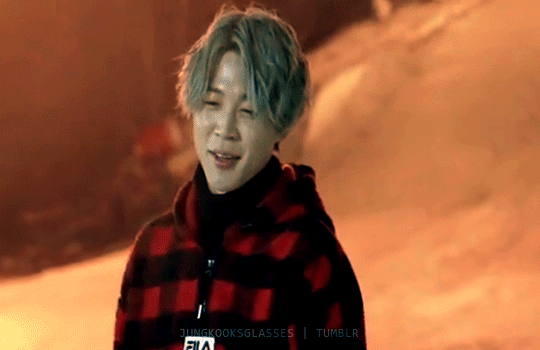
🫣 I SAID IT WAS DELUSIONAL OKAY
You are free to disagree. You probably should 🤣
I mean we know it wasn’t written by Jung Kook but obviously the version he recorded was arranged with and for JK, and “leave your body golden” can’t be a coincidence right? Like it’s the whole ass album name, plus a word that carries connotations of JK himself, which the ppl who worked with him on Seven must have known.
So if that wasn’t a coincidence… then what about:
1. “How we left and right is something we control” — a callback to both Left and Right by CP feat JK, but also a nod to Butter, a massive BTS hit and a song that he performs alongside his boyfie bestie JM.
2. “When it’s deep like DNA, something they can’t take away” — a callback to another massive BTS hit, interesting. And *delulu warning* also reminds me of JM and JK’s extreme similarities that they themselves have referred to before?? They’re wired the same, they have the same sense of humor, they live and breathe for the same shit and even though they have some very key differences, they really do seem like twin flames (even if you just see it as platonic). They are similar in ways that seem braided into the fibers of their being. Like, in their DNA 🧬 some may say. *delulu warning #2* I’m also reminded of Jimin’s Letter lyrics: “After all this time has passed will we still be the same? Just like we were when we first met.”
Also, “something they can’t take away” is an interesting turn of phrase… more on that later.
3. Okay the real meaty part:
Screaming I’ll testify that we'll survive the test of time, they can't deny our love. They can't divide us, we'll survive the test of time I promise I'll be right here
[I seriously can’t believe how closeted-couple-coded this song is]
First off, again with the Letter lyrics mirrored here with the “test of time.” Then it’s got all this drama about being ripped apart and how it won’t happen and how they’ll be next to each other no matter what and that they have “something they can’t take away.”
Not only does all that line up with other Letter lyrics, but it is so goddamn dramatic and for what?
Be for real, what straight couple in this day and age would have this much working against them?? The only possible explanations are: 1) within the fantasy world of a song I suppose this could be some sort of Romeo and Juliet/West Side Story motif, and to be fair the music video did have a kind of rival gang/crime family look to it? Sort of? With the men fighting below the stage? Idk. Or it could be 2) the fact that idols do in fact often have to hide even their straight relationships, which is wild to me. But I know it’s a thing, so. I suppose there’s that. JK doesn’t seem the type though honestly. I think he’d be even more open about it than V.
On the other hand, the lyrics seem SO fit for a couple who are a) queer, b) closeted, c) currently in/about to be in a legislatively homophobic military and country (am I saying that right? Lol) and d) internationally famous pop idols in the SAME BAND who are both widely regarded as heterosexual sex symbols and would be shunned by many people in their homeland AND internationally if their queerness were to be revealed, much less if they were truly an item and THAT news broke.
Whew. That was a lot but like… that would be a real example of a relationship that would be VERY threatened by outside forces plotting against them and trying to separate them. Not JK and a hot blonde model, not him and a Korean actress, not basically any other scenario but a queer relationship.
Idk I know he didn’t write it but like ??? What the hell is that theme? I’m dying to get inside the mind of the people who DID write it, because are they or are they jikookers at this point like?!
4. Just for fun I’ll also point out the “leave your body golden like the sun and moon” 😏 like. Okay. At this point the songwriters are watching Jikook compilations, drooling over @slaaverin edits like convince me they’re not. CONVINCE ME.
5. “Deeper than the rain”?! “The pain”?! Alright I’m not even serious at this point but ??? Rainy day fight 🌧️?!?! 🤣🤣
6. “Standing next to you” oh you mean like… for 18 months? In a companion enlistment program? Like that?
Alright alright I’m done but you get my point. What even is this song if not an anthem of jikookery?! It’s more on-the-nose than Letter, more sneaky than Still With You. It wasn’t written by JK but at this point I’m calling that the songwriters are as delulu as me.
Hope y’all are well. If you made it to the end of this thank you for donning your tinfoil hat with me and I hope you at least got a giggle.
✌️
200 notes
·
View notes
Note
All the fling posse song snippets are out !!!
👀 The Fling Posse snippets are all out now!! :D Ramuda sounds so happy I cry TwT
Hey! Any thoughts on the Fling Posse solo previews? Love hearing your opinions on the trailers and getting some neat tidbits of insight into the lyrics/motifs.
Thanks for the messages! Let's go check 'em out.
One and Only
(8 seconds in) Ramuda's saying "Let's go" too
(41 seconds in) Ahh!
(48 seconds in) Jesus, Shirai is really pushing his range in this one
(50 seconds in) Self love for Ramuda, hell yeah. Good on him
(End of video) Not a lot to say; I feel like this one was pretty straight-forward. It's Ramuda embracing his personal identity as a unique human being-- LOVE to see it-- which is the culmination of his arc through the series so far. The music itself didn't capture me. I might warm up to it later like I usually do, but Shirai's singing on its own isn't usually my cup of tea. Which is chill; I hope other people like it. The wordplay on "clap your hands (te wo tataite); I want to celebrate [being alive] (tataeteitai)" was neat.
Lies
(Title note) I'm intrigued that the title is in kana instead of kanji, giving it a simple and almost "honest" feel in its simplicity. It's been a hot sec since I've seen Gentarou use that word in writing but iirc he usually uses kanji for it.
(5 seconds in) Loving this piano.
(15 seconds in) A boku-using Gentarou? Bruh.
(35 seconds in) Ohhh I see the point of the kana. The title is the same as a famous Shuntarou Tanikawa poem narrated by a little boy (hence the lack of kanji). Since the song lyrics reference it, here's a quick 'n dirty TL of the poem: Lies I think I'll always tell lies. My mother doesn't, but she's done so before. I think that because I know lying is painful. Even if the things I say are lies, the lying feeling is the truth. There are some truths that can only be told in lies. Even dogs--if they could talk, I think they'd tell lies as well. Even when I tell lies, even when my lies get caught, I don't apologize. I never tell lies just to get out of trouble. (*) Even if no one knows that, I know that, and so here I am, living with my lies. Until I just can't bear to lie any longer, I know I'll lie again and again and all the while long for the truth. (*) Literally, "resolve [the trouble] with apologies" which is why the narrator says he doesn't apologize Anyway, the "Even when I tell lies..." verse sans "and so..." is the opening of this song. Gentarou stops at "Even if no one knows that" and sighs in his second repetition of the verse.
(end of song) Wait, the whole thing is just verses of this poem? This is really cool and artistic (I dig it) but wow, what a choice! Saitou Souma's performance is incredible, and the background music is cool. I don't know how well this would go on a playlist, but I am here for it! ...I'm also wondering what the rights acquisition must have been like. This poem isn't in the JPN public domain yet, right? Hahaha.
God in the Dice
(title note) Fwiw I usually say Dice has "spirits" in his dice; calling them gods is just as valid. That seems to be what this is referring to.
(15 seconds in) Man I love Nozuyama's rapping chops. He delivers every time
(23 seconds in) Going to take this "I don't care" and make it a reaction image. Can't adequately express how much the phrase "Thog don't care" gets me through the day; this is right up there with that
(29 seconds in) It's very, very funny that Gentarou always teases Dice about his lack of vocab when you compare these two songs back to back. Hahaha.
(50 seconds in) Call back to Scramble Gamble with a more positive outlook. I can fuck with that.
(end of song) This one seems very similar to Ramuda's in terms of message (once again, I'm inappropriately amused at the notion of Ramuda and Dice living it up in the booth like "Love yourself...! Respect yourself! Love yourse--" and then it cuts to Gentarou who's got a piano and a Dramatic Poetry Reading and Angst. Well, that's Gentarou's way of loving himself, I suppose) and on the one hand, I am very happy for Dice deciding to live his life his own way, even if it goes against societal values... but I don't know how I feel about indulging in a gambling addiction as a way to explore that. You know? Maybe I'm just going "You don't have to follow societal expectations, but you should follow MY expectations, dammit!" Hahaha. Well....... Do what you gotta do, homie.... I'm reminded of how very 20 Dice is. Very, very 20 y.o. leaving a bad home life. Do what you gotta do....
Well, that's Fling Posse! Very much their usual Fling Posse selves.
40 notes
·
View notes
Text
Defying gravity in every aspect is very important to me!!!! Something about the instrumentals and lyrics just make me emotional!
Also I’m a sucker for callbacks or motifs to other pieces of music. Like that part where Elphaba goes “unlimited” and it sounds like somewhere over the rainbow. GOSH it’s genius. I just can’t stop listening to it. Cynthia Erivo you are a gem!!! You will always be famous!!!!!
Ooooh and the end after her battle cry when the ensemble sings that chord and then it goes back into the instruments omg I love it
#wicked#elphaba thropp#glinda the good witch#galinda upland#defying gravity#love music#could talk about this forever#music nerd
21 notes
·
View notes
Text
youtube
hey can i just yap abt how much i love this particular score in the ac3 ost
one of the top comments said it best:
"You know what really gets to me? By 1:40 you can hear Haytham's theme, interwining with Connor's style, creating something sad, but beautiful. It tells the tale of grief, of a story finally coming to an end. It's depressing in a way, but beautiful nonetheless."
as someone who loves musicals, a form of art where leitmotifs are often used, this score hit me in the feels T_T
if you've listened to the ac3 ost, haytham and connor have contrasting motifs in their respective themes. haytham's theme sounds much heavier, allowing its listeners to get to know haytham's character: a domineering and powerful leader. his theme also reflects his aristocratic background, using classical melodies like those used by famous maestros of his time. whereas connor's theme sounds lighter and its rhythm is much slower than haytham's. the native flute is ever present in the piece, and i'd argue that it's the one that guides the piece entirely. the native instrumentals featured in the score and its steady and unrushed rhythm also reflect connor's heritage as a kanien'kehá:ka and his character as a naive young man who had lived a life of tragedy respectively.
haytham's theme, with its strong and powerful elements reflects his place in society as an influential and sophisticated leader. a theme fit for a grandmaster. connor's theme, with its measured motifs and use of native instrumentals, reflects his identity as a kanien'kehá:ka warrior who, at the same time, exudes innocence and naivety to the complicated and foreign circumstances his own land and culture were subjected to.
and when i listened to the music used during their fight? OH GOD THE LEITMOTIFS IM SCREAMING
the intertwining of BOTH their themes was IMPECCABLE. at first, haytham's theme dominated the piece, with the native flute that was used in connor's theme sometimes chiming in in little intervals. and when the piece was coming to an end, we can hear the native flute even more clearly. and yk what's crazy?
we hear the native flute, but it's not connor's theme that was playing.
the native flute was playing haytham's theme.
this was the very moment in the score where their respective themes weren't clashing with each other, where one theme wasn't playing louder than the other.
this was the moment their themes worked together to create a perfect harmony, as if it portrayed their reconciliation and, arguably, forgiveness.
i could go on and on about this but I really couldn't find the words to describe the beauty of the game's soundtrack. if anyone else would like to comment on this, pleaseeee do!!! i really wanna see other people's take on this because i love talking about video game soundtracks and especially ~leitmotifs~
#assassin's creed#assassin's creed iii#ac3#haytham kenway#connor kenway#ratonhnhaké:ton#video game soundtrack#leitmotif#musical analysis#Youtube
19 notes
·
View notes
Text
That's Entertainment
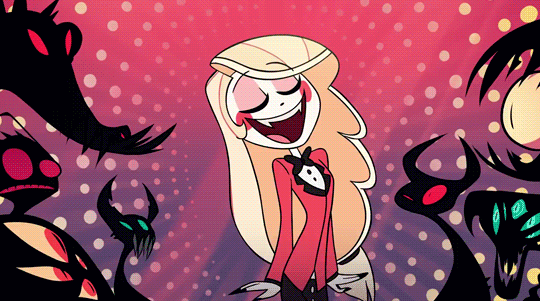
The Hazbin Hotel's Pilot is called "That's Entertainment". The title is a tongue in cheeck joke, as the series is good entertainment, but it also references "That's Entertainment!", a song from The Band Wagon musical. This song is quite famous and it became an anthem of sorts for Hollywood as a whole. Here it is its final stanza:
The world is a stage The stage is a world Of entertainment!
Does it sound familiar? It should:
Alastor: After all, the world is a stage and the stage is a world of entertainment.
Why is there such a reference in the Pilot?
There are two reasons:
Hazbin Hotel is a series with allusions to musicals, movies, memes, fairy tales and different mythologies. All these references tie into the story and characters by commenting plotlines and arcs. So, The Band Wagon's easter egg is the same.
Both The Band Wagon and Hazbin Hotel are meta-stories. They are pieces of entertainment about making entertainment. "That's Entertainment!" (song) has something to say about musicals. "That's Entertainment" (pilot) has something to say about stories.
So, Hazbin Hotel is full of references that can be read:
On a story or character level - in the sense that they enrich the series and its protagonists
On a meta-narrative level - in the sense that they metaphorically comment on the entertainment industry
Let's analyze these two layers of reading, when it comes to some motifs and characters. Of course, let's start from one of the oldest creative minds of the universe. The very first dreamer:
Charlie: Lucifer was one of these angels. He was a dreamer with fantastical ideas for all of creation.
LUCIFER: THE GREATEST SHOWMAN
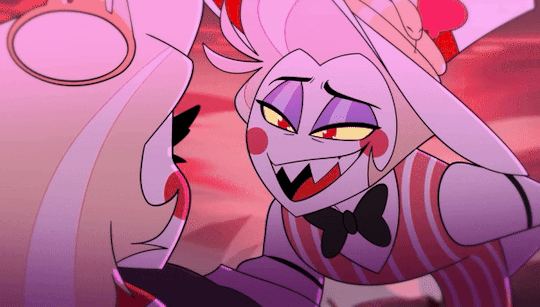
Lucifer is a dreamer both when it comes to morals (story and character level) and to creativity (meta-narrative level).
Morals - Lucifer's first big project is to share free will with humanity:
Charlie Morningstar: Together, they wished to share the magic of free will with humanity, offering the Fruit of Knowledge to Adam's new bride, Eve, who gladly accepted.
Lucifer and Lilith's plan was to give humanity knowledge, so that they could challenge the system and decide for themselves how to live. It is an ideal rooted in the faith people can be amazing, when in charge of their destiny.
Creativity - Lucifer is so passionate about "creation" that he turns Hell itself into a big colorful show. A seven-ring circus full of acts and performances happening at the same time. This is the metaphorical meaning of Hell's circus motif. This realm is the greatest shit-show of all times and Lucifer is its creator. He is the Greatest Showman. After all, Lucifer's known activities are:
Its previous shows with the Seven Deadly Sins' Troupe
A theme park called LuLu World
An App similar to Ticketmaster, which is called Lucimaster
These are all linked to the entertainment industry. Isn't it strange that the King of Hell has such a specialization? Shouldn't he have control over a more strategic part of the economy, like industry, banks or health? And yet, entertainment is Lucifer's domain because deep down Hell is nothing, but a showbusiness factory.
So, Lucifer is at his root a wide-eyed idealist, both when it comes to his political stance and to his creative process. And yet, Lucifer gives up on dreaming:
Charlie: Ashamed, Lucifer lost his will to dream.
He stops seeing the good in others and loses hope for the system and people alike to change. He can't imagine a different future than the sad and lonely present he lives in.
He is stuck creating "ugly ducklings" he himself dislikes:
Lucifer: That's it… Almost there… Now presenting… the magic-tastical back flipping rubber duck! Haha! That spits fire! Hoo hoo hoo! Hold the applause please, okay. Oh, thank you, thank you. Oh god, who am I kidding? This sucks!
Lucifer's creative block is conveyed also by some details set up in the Hellaverse. For example, Helluva Boss shows another sin, who is very active in the entertainment industry.
WHEN MAMMON STOLE THE SHOWBIZ
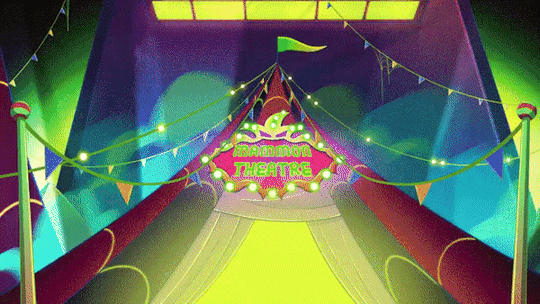
Mammon, King of Greed apparently breaks an established pattern in Helluva Boss. In this show, every sin is introduced by a song focused on their vice.
Asmodeus, King of Lust, has House of Asmodeus:
Asmodeus: You singing love songs in my lustful lounge? Fizzarolli: Ozzie's ain't the place for sentimental sounds! Asmodeus: What'd you expect from a proprietor like us? Fizzarolli: Your demon host, Asmodeus, the embodiment of lust! Asmodeus: Give me a thrust! Fizzarolli: Bwabwabwabwa bwaaaah- Asmodeus: Show me some lust From the groin to the bust In desire, we trust In the house of Asmodeus
Beelzebub, Queen of Gluttony, has Cotton Candy:
Hey! I'm whatchu need, I'm watchu want I got it all, a carnival I'll bring you up, I'll take you down I'm sticky sweet, stuck in your teeth Like cotton candy Cotton candy (Ah-ah, ah-ah) Cotton candy (Ah-ah, ah-oh) Cotton candy (Ah-ah, ah-ah) I'm whatchu want Not watchu need (Ah-ah, ah-oh)
What about Mammon? The King of Greed has actually a lot of songs that explore his sin. Let's think about what his debut episode is called: "Mammon's magnificent musical mid-season special (ft Fizzarolli)".
Mammon doesn't sing nor performs, but the musical is still his. Fizz, who is the main character of the episode, gets only a mention.
In other words, all the songs featured in the mid-season special are Mammon's songs. They do not directly say anything about greed, but they comment on this sin in a meta-narrative way:
Octavia: Is it true this park is just a really shameless spin-off of Lucifer's far more popular Lu Lu World?
The Sin of Greed steals others' talents, so his songs are stolen songs. Loo Loo Land is the perfect example of this:
Everybody's friendly And nobody is mean No copyright infringements ever seen I have a dream (He has a dream) I'm here to tell (He's here to tell) About a magical fantastic place Called Loo Loo Land
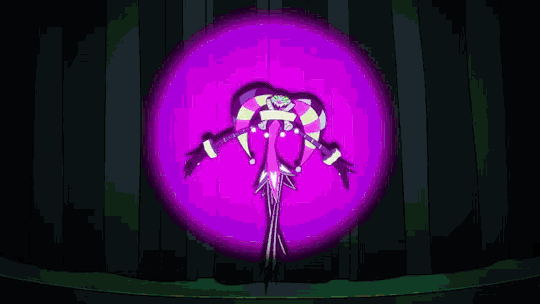
This song has Mammon:
Profit of Lucifer and his Lu Lu World theme park
Rip off Charlie's Inside of Every Demon is a Rainbow song
Possess Fizzarolli's body
The King of Greed is a talentless performer:
Asmodeus: Also, you are a waaaay better performer than Mammon ever was, and thaaat's just facts.
Still, he is good at marketing and is slowly stealing the showbusiness for himself. He organizes pageants, finds new talents to exploit and has convinced Hell's middle class that being a clown like him is the coolest thing ever:
Fizzarolli: It's not about that! It's getting to work with my idol. I just love that he's giving someone new the chance to be in the spotlight! He's an inspiration. Blitzo: Well he's- definitely something alright. I mean, I dunno, was it worth all our savings just to have him put on an over-hyped commercial, and then bitch about taxes, and then assault us with clowns, vomit, and pass out on stage? Fizzarolli: So worth it!
What does it all mean for Lucifer?
On a character level, it ties with Lucifer's depression and general sense of failure. He is a Seraphim, the King of Hell and a brilliant artist and performer. And yet, he can't stop one of his subjects from ripping off his ideas. Once again Lucifer's dreams are ruined. They become soulless and rotten. Moreover, the one doing this is a member of Lucifer's own Circus Troupe, which adds to the impression of isolation and loneliness Lucifer gives off.
On a meta-narrative level, greed is corrupting the entertainment industry, as the dreamer in charge of it feels unmotivated and uninspired. This is a pretty poignant and tongue-in-cheeck dig to the current state of things, where corporations are mass-producing empty stories. After all, Lucifer fits the Mr Alt Disney TV Trope:
A No Celebrities Were Harmed version of Walt Disney; expect him to be the animator of a world-famous cartoon character (frequently a Mocky Mouse) and/or the founder of Souvenir Land. Also expect an exaggerated interest in planned communities and/or creating a utopia, possibly with sinister undertones. He'll present said utopia in the form of a World's Fair-like exhibition, usually in his parks. Many of these characters go beyond parodying just Disney and fuse him with Howard Hughes, another mustachio'd early/Golden Age of Hollywood impresario and futurist. Hughes gradually became debilitated by severe mental illness (OCD and agoraphobia) and eventually was reduced to living in seclusion, obsessively carrying out odd habits.
Lucifer is an oddball with a Showbiz Empire in Hell. He is loosely an expy of Walt Disney and the old Hollywood, but he is now tired and unable to produce anything new. Luckily, there is a beautiful disney-like princess ready to help him.
HAZBIN HOTEL, THE GREATEST SHOW
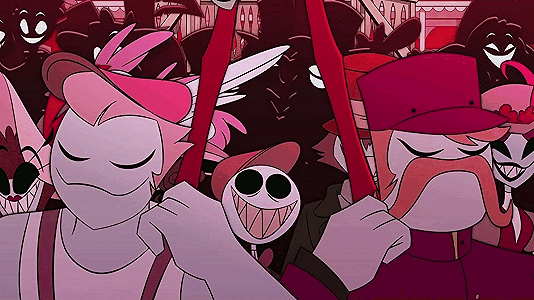
Charlie is a disney princess with the twist she reigns in hell, rather than on a classical fairy tale kingdom. In particular, she resembles Rapunzel in both design and personality:
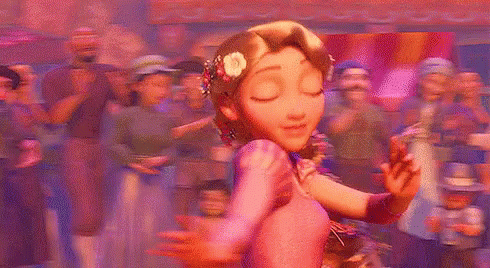
Both princesses wear their hair tied, but they let it loose when they use their powers. They are enthusiastic, able to inspire others, but also sheltered. So, they are a bit childish. Charlie is basically Rapunzel if Raps were met with a cynical world the moment she escaped the tower:
He's got a dream He's got a dream See, I ain't as cruel and vicious as I seem Though I do like breaking femurs You can count me with the dreamers Like everybody else I've got a dream
Inside of every demon is a rainbow! Inside every sinner is a shiny smile! Inside of every creepy hatchet-wielding maniac, Is a jolly, happy, cupcake-loving child!
Rapunzel enters a sinister inn, shares her dream and is validated and understood by a bunch of bandits. Charlie explains her goal to all of Hell and is humiliated and laughed at by everyone.
Despite this setback, Charlie is still a disney-like princess and throughout the first season she brings dreams to others. This is true especially for Lucifer:
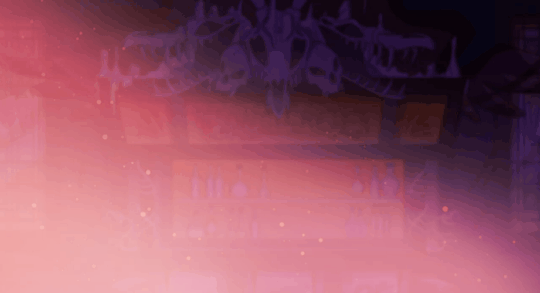
The King of Hell's dreams are awaken by Charlie's Hazbin Hotel project in two ways.
On a character level, Charlie's Hazbin Hotel is the evolution of Lucifer's dream, as it is rooted in the belief human souls can choose goodness. Even after death:
Charlie: Don't you care, Sera? That just because someone is dead, it doesn't Mean they can't resolve to change their ways Turn the page, escape infernal blaze
On a meta-narrative level, Hazbin Hotel is the greatest show. It is a new series, which takes obvious inspiration from classics, both disney movies and musicals. However, it is still fresh and innovative. Similarly, its protagonist is a disney-like princess (Charlie), who inspires a Walt Disney expy (Lucifer). She is a creation (daughter) giving hope to her creator (father). This is why by the end of season 1, Lucifer finds some of his old creative drive, as he helps Charlie rebuild the Hotel:

Lucifer: Remedial creation for me... it's as easy as can be!
Charlie brings back both hope (story level) and entertainement (meta-narrative level) in hell:
Alastor: Hahaha, why does anyone do anything? Sheer, absolute boredom! I've lacked inspiration for decades. My work became mundane, lacking focus, aimless! I've come to crave a new form of entertainment! Hahaha!
She has the talent to renew a showbiz (hell), which is mundane and aimless. She has a freshness, which catches the eye of navigated entertainers:
Alastor: She's filled with potential that I could guide Rosie: I concur Rosie and Alastor: Stick with her, you'll be on the winning side
Still, why is that so? Why is Charlie such a good entertainer?
CHARLIE: THE PERFORMATIVE DREAMER (CHARACTER LEVEL)
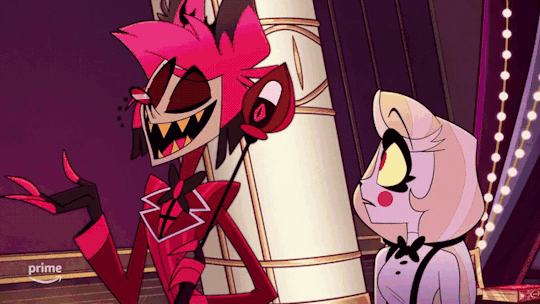
Charlie is entertaining because:
She tries hard to keep up her smile, even if she is suffering inside. In this sense, she is a real performer
She is so dedicated to her objective, that she is ready to do anything to reach it. In this sense, she is a true dreamer
Charlie, the performer
Alastor:Just because you see a smile don't think you know what's going on underneath. A smile is a valuable tool, my dear. It inspires your friends, keeps your enemies guessing, and ensures that no matter what comes your way, you're the one in control.
Charlie is a character, who masks her negative emotions behind smiles, enthusiasm and an apparent neverending optimism. In reality, she struggles a lot with who she is:
Alastor: Welcome to the Hazbin Hotel, a misguided path to redemption! Founded five days ago by Lucifer's delusional daughter, Charlotte Morningstar! Come place your fate in her inexperienced hands, as she tries to work through her daddy issues by fixing you!
Has Charlie founded the Hazbin Hotel to help sinners or to find herself a purpose? The answer is both. Charlie's project is born from genuine altruism, but also from a selfish desire to matter.
Charlie, the dreamer
Alastor: You have a dream! You wish to tell! And it's just laughable. But, hey, kid, what the hell?
Charlie's dream seems impossible, almost a delusion. And yet, Charlie keeps pursuing it, no matter what. She sings her heart out to advertise the hotel... only to be seen by everyone as a joke. Still, she keeps going. She doesn't give up on her project.
Alastor: Consider it an investment in ongoing entertainment for myself! I want to watch the scum of the world struggle to climb up the hill of betterment only to repeatedly trip and tumble down to the fiery pit of failure!
Seeing Charlie struggle is fun because even if she fails, she tries again. She experiments new things, she learns and she teaches. She apologizes and she forgives. She never quits. So, she is an entertainer.
Charlie: I have a dream, I'm here to tell! About a wonderful fantastic new hotel!
CHARLIE, THE PERFORMER FULL OF DREAMS (META-NARRATIVE LEVEL)
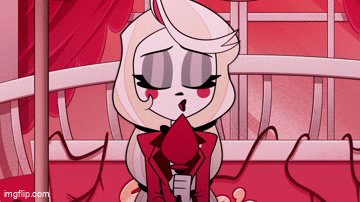
Charlie puts up a performance and follows her dream no matter what. She hides within herself a selfish motivation (fiction), but earnestly pursues her selfless dream (reality). Similarly, Hazbin Hotel is a story (fiction) with a strong heart (reality).
That is because entertainment is rooted into reality:
Anything that happens in life Can happen in a show You can make 'em laugh You can make 'em cry Anything, anything can go (That's Entertainment! - The Band Wagon)
Charlie: Does getting into a fistfight with a reporter count as entertainment…? Alastor: Hahaha! It's the purest kind, my dear: Reality! True passion!
The song states anything can be entertainment
Alastor claims that good entertainment is born from genuine passion
It is the same idea declined in different ways. Entertainment is a representation of the world, of its flaws and beauties. It is fiction, but in a sense it must stay true to itself. Just like Charlie herself is both a performative dreamer (fiction) and a performer full of dreams (reality):
She is a performative dreamer because deep down she feels she must be perfect and repress her negative feelings. Only in this way she has value. She masks herself with a pollyanna persona.
She is a performer full of dreams because she has the talent to maker her dreams come true and to become a real artist in the process. To succeed, though, she should not ignore her hidden parts. She must face reality.
THE WORLD IS A STAGE AND THE STAGE IS A WORLD OF ENTERTAINMENT
When fiction and reality meet, entertainment is born. This is what Hazbin Hotel's meta-message seems to be. A story is invented, but the feelings behind it must be genuine.
At the same time, entertainment helps people better understand themselves. This may be why Hazbin Hotel is full of entertainment motifs. Here are some:
Charlie is a singer
Vaggie is a dancer
Angel is an actor
Alastor is linked to radios
Vox is a TV demon
Valentino is a director and producer
Adam is a musician, whose arc is described by the musical "School of Rock"
Charlie and Alastor's bond is commented by the musical "Annie"
For each one of these references, one could write a meta (I hope I will for some tbh). That is how much the idea of entertainment is intertwined in the story. In conclusion, it is definately true that:
The world is a stage = Fiction must take inspiration from reality or it will feel hollow
The stage is a world = Stories can help to better understand reality and make sense of it
Hazbin Hotel is a piece of entertainment about entertainment, which is best understood through the lens of entertainment. In short, it is entertainment!
#hazbin hotel#hellaverse#hazbin hotel meta#charlie morningstar#lucifer morningstar#charlie hazbin hotel#lucifer hazbin hotel#mammon helluva boss#my meta
39 notes
·
View notes
Text
youtube
IT'S DONE IT'S DONE IT'S DONE IT'S DONE
I've been grinding away at this for months. I can't wait for people to see it. This project turned out to have a lot of gears behind it, so check out the artist statement below!
vvvvvvvvvvvvvvvvvv
I love this song. The first time I heard it, I already began picturing a story where a woman stumbled upon a gathering of birds in the forest and became so enthralled by their song that she partied with them until she became a bird, herself. It turns out that isn’t too far off from the singer, Yma Sumac’s, first experiences learning to sing. She would imitate the animals near her home in the hills of the Andes mountains as a very young kid, developing a vocal range that would make her famous later on.
From there, I fell into a montage of research on her life and the Peruvian festival music that defined her early career, as well as the complicated story of the exotica music she became most known for in the United States. I followed that up with a month-long dive into northwest Peruvian culture, mythology, ornithology, flora, and topographical studies. Then, I blacked out somewhere during the drawing phase, and now I’m here.
While I really value what I’ve learned while doing this project, I think it’s important to note that I did it all as an amateur researcher and a foreigner to the subject. I decided it would be a little conceited to try to make a totally accurate depiction of a traditional Peruvian festival, so I instead focused on referencing the regional variation of these traditions. Costumes and music have their own specific designs and textures depending on the area, and dances and festivities reflect local history. Yet, it all shares the same themes of celebrating prosperity and surviving hardship. Common motifs and characters reflect a shared heritage and cultural identity that coexists with individuality. It’s all just very cool to me.
So I asked myself, what if these birds had their own version of these traditions? What would a bird sing a folk song about? What would be new and cool to Yma, but still familiar enough that she could join in? (I got lucky, since Peruvian festival culture is already very reverent of birds and feather patterns.)
What I ended up with pulled a lot from the Carnaval de Cajamarca, which originated in the next town over from Yma’s childhood home of Ichocán. It also references these dances, among others:
Huaylarsh - Los Emplumados - Marinera - Tondero - White Dance / Los Chunchos
It’s also important to know that I took a lot of creative liberties with my research to pull the story together. I hope I haven’t used any elements in a harmful or insensitive way–and if I have, I’d like to know so that I can apologize. (I also missed out on some cool stuff, like the White Dance always having shaker beads on the legs.) I highly encourage you to have a look at some of the sources I did, and to look further if you’re interested. I found it all very enlightening, and I hope you will too.
Yma’s wikipedia, which seems like a mostly accurate overview based on other sources
Her official website, curated by a fan and friend
A segment on NPR about her musical career
The interview I got the opening from
The ornithology archive that saved my ass
I’d like to work on uploading all the frames as an image reel somewhere so they can be looked at individually. Might take a while, though.
Thanks for watching!
(To those using a screen reader, the video description follows this message. I'd like to apologize for putting the description as the last thing on the post. Not only is it extremely long, but this seemed to be the rare instance where the description would benefit from the context of the post's commentary before being read itself. I wrote and formatted this description in a way that I hoped would apply to aid various disabilities that impede enjoying music videos, and I am very interested in getting feedback.)
DESCRIPTION
[The following is presented as an animatic (a series of still images edited into a video) set to music. The art is drawn with condensed yet fuzzy pastel-like linework and full color. The song used is “Chuncho” by Yma Sumac. The song was composed to imitate the various sounds of tropical birds and animals. It has no lyrics, at least in a traditional sense. I, the describer, have tried my best to translate the especially abstract nature of this song into language that can be interpreted through text. Please use the best of your imagination to fill in the rest. An audio description will always refer to the visual description that follows it.
Audio: A male interviewer asks, “Since you are referred to the bird who became a woman in your native Peru, Ms. Sumac, may we hear your exotic voice?”
Visuals: A title card appears with gold lettering on a black background. It reads one word: Chuncho. The word is depicted as if it were carved into a flat surface with loose individual strokes.
Audio: A woman answers, “I will try to imitate the birds, as I did in my earliest years in the mountains of Peru.”
Visuals: Credits appear, also in gold text: Sung by Yma Sumac (Zoila Augusta Emperatriz Chàvarri del Castillo. Drawn by Carlie Hughes (rainbowchewynuggets).
Audio: The music begins with the steady four-note strumming of a guitar, which will continue throughout the song. Then, it is accompanied by low ragged notes from a heavy woodwind instrument.
Visuals: A green cicada flicks its wings as it rests on a plant with jagged leaves and a little white flower growing from the middle. Beetles of green, red, and yellow crawl around on trees and ferns among puffy yellow blooms. Yellow humpback beetles huddle together on a cold stone surface as mothlike butterflies cling to hanging purple-grey moss in the background. A cluster of butterflies of black, green, blue, orange, purple, and red flare their wings along stems and vines. A line of spiny cocoons hang from a vine leading up the center of the group.
Audio: A vocalist, the same woman as before, begins to sing in vocables. Her first notes are short, round, and bubbly, like the chirping of a small bird. The lilt of a flute follows.
(“B-bm, bui-bui-buiii…”)
Visuals: A small village sits on the side of a forested and scrub-covered mountain at night. Buildings twinkle with yellow and blue window light through the darkness. At the edge of the forest, a tall lean woman appears with warm orange skin, long black hair, a simple green dress cinched at the waist with blue trim on the neck, hem, wrist, and waist, and a powder blue shawl tied at the chest. She sneaks away from the village into the temperate tropical forest, glancing back to make sure hasn’t been followed. She grows more at ease as she leaves the buildings behind and strides between bushes, deeper into the trees. She passes a flowering plant with orange petals. Its bulbs are held aloft on long, long stems.
Audio: The vocalist sings in elongated threads of notes, wavering in a minor key in a mischievous way.
(“Whu, hu-uuuu…”)
Visuals: The woman grazes her fingers along a bush with little black berries and white spiky flowers. Her hand passes up and down with the shape of the bush, like the rise and fall of an ocean wave. She walks uphill, past pink clover and increasingly frequent stones.
Audio: The vocalist clicks and rolls her tongue with her notes, like drops of water splashing across stones.
(“Dlu, dlu-dlu-dlu-dlu-buiii…”)
Visuals: A voice suddenly gets her attention. The voice passes by as a green line with wide wave forms. The woman follows it. She passes through a stone forest–dense moss-covered rock formations that reach up toward the sky. The ground below is streaked with snake trails. The line of song is now yellow. It leads her forward along a trail through the rocks. She climbs a more precarious formation of boulders, through dense shrubbery and a dramatic rocky landscape. As the voice shifts redder, her colors shift pinker. Even the environment’s colors are shifting to pinks and blues. She climbs a hill, past tall spindly trees and a nearly vertical mountainside. The pink line of song leads her still upward.
Audio: The vocalist belts out the deep throaty call of a tropical bird trying to be heard far and wide. The notes increase in frequency, then widen into a whoop that softens to a murmur. The flute follows her with a few short forceful notes.
(“Ah, bya bya bya-bya-bya-bya-bya-byaaa, whoa-whoa-whoa-whoa-wi, wa-wa-wa wiii…”)
Visuals: When the woman reaches the top of the hill, a light shines up at her from the other side, returning her original colors. Below, she sees a gathering of human-sized bird people celebrating on a leafy platform. They’re dancing in different sized circles around a tree at the center. Rainbow colored ribbons of different lengths have been tied to the branches of the tree and hang down to form the silhouette of a condor. More ribbons and colorful bulbs hang from the leaves above. The line of song (now light blue) travels in a circle around the tree trunk. The camera zooms in, revealing details of the birds and their costumes. The birds are pigeons, hawks, cuckoos, seedbirds, and corvids. They’re all dressed in colorful hats, vests, slacks, and dresses with patterns that reflect those of their feathers. A circle of spotted woodpeckers closest to the trunk wear purple gowns and party hats. The party’s singing expands the blue circle of light. A wider circle of yellow, green, and white birds sit and watch the celebration from the edges of the platform. As a line of bright manakin birds zip by with their hands clasped together, the woman approaches from a nearby branch. She’s enticed by the party and joins the dance, clasping hands with a green parrot and leading the line with a broad smile on her face.
Audio: The vocalist makes a quick sudden series of escalating notes, then makes a hard sound with her teeth and returns to a low whoop. The flute echoes her.
(Ba-bana-baba-cht!, waw waw waw waw waw waw waw wiii…”)
Visuals: The birds switch to individual dances. A short red woodpecker and a tan long-necked bird with ribbons in her hair dance and sing together, their lines of song intertwining. The woman and three pigeons in red and black dresses stomp their heels in a quartet dance. She follows their steps flawlessly, familiar with the type of dance. When they begin to sing and whistle, she joins them–though her voice isn’t as strong as theirs and her line of song is thin and brittle.
Audio: The vocalist makes a low growl, at first imperceptible, that grows to a steady rumble. The flute follows.
(“Rhhh…, rhh, rhh rhhh…”)
Visuals: Then, the lights darken and redden. The woman stops to notice all the other birds heading to the back of the platform. They climb and flutter up to sit in fruit-bearing branches that grow just beyond. The woman finds herself a spot and picks a piece of fruit to eat. She takes a bite as a show begins. A band of various birds wearing ponchos and cloth hats sit down by the show platform. They play their instruments (flute, guitars and a drum) and count in the performance.
Audio: The vocalist makes more short bubbly chirps. They grow higher in small strings of notes until the phrase ends with a low long note.
(“Bom-bom, t-bom-bom-bom, mbom-bom wiii…”)
Visuals: Five owls appear, bathed in magenta spotlight before the center tree trunk. All of them have their yellow-spotted wings wrapped to mostly cover their black and gold-trimmed dresses. The four owls on the sides are short and red, while the one in the center is tall and bright purple. As all five begin to sing a golden song, they operatically open their wings and extend their feathers. As the light darkens to violet, the black and gold patterns in the folds of their wings leap out as if exposed to blacklight. They extend their arms upward and then double over to kneel on the stage, fully splaying their wings in a dramatic display. The woman watching is transfixed.
Audio: The vocalist rolls a noise from the back of her throat. Once, twice, three times–before hitching the roll up and down and letting it trail off. The flute makes a low hollow arc of a note.
(“Ghhh, ghhh, ghh gh-gh-gheee…”)
Visuals: Cut to the next performance. Two teams of blackbirds with long waving feathers compete, standing on each other’s shoulders to form two pyramids. The one at the top of each team lunges forward to try to strike the other with a long stick, propelled by their team. Their feathers glow with yellow light from above. The team on the left—with orange vests and red sashes—strikes first, only nearly missing. They gloat as the lime vest and green sash team on the right recoils and protests. Then, it’s the green team’s turn to take a confident lunge, forcing the red to frantically pull back in time to dodge. On the next strike, the red team buries the stick in the top of the enemy pyramid (actually tucked under the green leader’s arm). The victim feigns a mortal wound, and the entire team flies away. The red team poses, victorious. The red leader gets down to the floor to greet the widow of the green team, wearing a green dress. She peers at him from behind a silky black wing. As soon as he lands, she whacks him over the head with her own concealed stick. He is surprised. She is unamused.
Audio: The vocalist lets out a ghostly wail that wavers wildly like an eerie wind, higher and higher. A shaker instrument rumbles beneath her voice.
(“Woaaa… woaaa… woaa–”)
Visuals: Next, it’s dark. Three colorful birds in masks and costumes tread the air at an angle on the left side of the screen against a blue and green background. There’s a yellow spiky one, representing lightning. A blue round-feathered one, representing rain. And a spade-feathered green one, representing trees. Long beaded threads tied to their wings and tails wave and tangle across the screen as a group of five hummingbirds in shades of red struggle to survive the “storm” raging around them. The colored ribbons of the central tree are muted and flutter with the power of the wind. Two other birds hug the trunk, nearly out of sight. There’s a prop on the floor to the right made to look like a stone alcove, where more hummingbirds are hiding. The storm bringer birds beat their wings hard, casting the strings of lightning, water, and leaf shaped beads in huge chaotic waves. The five hummingbirds in vests and dresses wince and tumble against the wind, flying together in a tight circle. The threads crisscross behind them, an overwhelming force on the tiny birds’ scale. A red line of song floats up to reach them, guiding them down to the nest.
Audio: When her wail is at its highest, the vocalist pushes it further into the voice of a shrill songbird. The note hangs high in the air, then takes a few steps down and up. The segment ends with the sudden interjection of the low round voice–as if in surprise–and a trailing mumble.
(“Haaa, aa-aa aa-aa aa-aa, hoa? Ah, bw-huh…”)
Visuals: Those in the stone nest finish singing and reunite with the others, pulling them down to safety. A blackbird hiding behind the trunk spreads its wings, sitting on the shoulders of a brown woodpecker. The blackbird’s vest and wingspan are covered in yellow, signaling the coming of daylight. The storm birds retreat and sit still on a nearby branch. The wind is suddenly gone.
Audio: The guitar plays alone.
Visuals: After the stage performances, the audience members move back to the platform. They’re gathered off to the far left side of the central tree trunk, standing in a circle around a single figure. The light of the gathering area is deep plum-purple in far off areas and warm dull pink over the crowd. The empty space around the single dancer is salmon red, and the figure herself is blue.
Audio: The vocalist perfectly mimics the sound of a flutter, of delicate waving in the wind.
(“W-w-w-w-w-w-w”)
Visuals: The camera zooms in on her hand as it flits a pink handkerchief in the air.
Audio: The vocalist belts a pair of bold staunch vocables. The second note is held for several seconds before fading out.
(“Kyen, kyen…”)
Visuals: The camera pulls back to reveal the rest of her. She’s a blue eagle with wings that grade from red at the arms to pink to blue at the wingtips in a wavy pattern. Her smiling beak is bright pink. Her dress is royal blue with reddish-pink trimmed ruffles on the hem of the skirt, waist frill, neck frill, and the flower decoration on the side of her head. She stands with the hem of her dress in one hand and the handkerchief extended in the other in an open invitation to dance. A pale pink spotlight frames her head and shoulders against the darkness, and a dark pink line of song passes behind her. Her partner, an eagle of the same coloration with a blue vest and pants, pink shirt, pale orange sash, a blue hat in one hand, and a pink hanky of his own raised in the other, is calling to her. He puts his hands behind his back and takes high steps toward her. When the two are close, they turn and walk parallel to each other in a slow circle. The male’s back is to his partner. He looks at her over his shoulder with a smile and abruptly splays his feathers to be cute. There’s a layer of pink under his outer coat. She grins, entertained.
Audio: The vocalist repeats the two vocables, twisting the end of the second up into a high wavering trill that eventually soothes and disappears.
(“Kyen, kye–eee, ee, eee, ee…”)
Visuals: The two turn to face each other, circling tighter and tighter in unified song until they’re face to face, looking deep into each other’s eyes. With another turn, they’ve passed by each other and out of sight.
Audio: The vocalist makes a whisper, a ghost of the two vocables. Then, a few quick whistles, barely loud enough to hear.
(“Hyo, hyo”)
Visuals: The woman, who has been captivated by the dance, suddenly notices that the crowd has dispersed around her. Partners are walking off in all directions, leaving her alone. The dance is over.
Audio: The guitar picks up, getting faster and louder for a bit.
Visuals: The woman walks alone in the blue night air along a tangle of tree branches that form a pathway. She walks with her hands behind her back, her face looking preoccupied and a little disappointed. Bushels of soft leaves pass by in the background.
Audio: A high, light pleasant note from the vocalist overtakes the guitar. It grows until it fills the soundscape.
(“Aaa…”)
Visuals: An orange song reaches her from the direction she came, and she stops. When she turns, she sees a blue swift standing on the branch path, far behind her in an opening in the trees. The underside of his feathers is dingy orange, and he’s wearing a black vest, white pants, a rusty red sash around his waist, a bright green kerchief around his neck, and an orange rectangular accessory tied around his neck like a necklace. His face is obscured by a white hat with an orange band. He bows low with a hand on the hat. The hat comes off, revealing inviting eyes and a smiling orange beak. The woman grins and accepts the invitation with determination.
Audio: The vocalist draws long high vocables that resemble a wail. They trail off with a low note.
(“Whoa whoaaa…”)
Visuals: She and the swift untie the fabric around their necks and step toward each other as the line of song forms a ring above them. The woman holds the ends of the shawl in her hands and her hands at her hips with the body of the shawl hanging behind her waist. The bird holds his kerchief out in one hand with the hat in the other, held behind his back. He takes measured winding steps along the branches. The woman mirrors his steps, then pushes off of the main path and lands on an outcropping branch.
Audio: The vocalist’s song wavers back up and demurely bobs up and down, intertwined with tweeting from the flute.
(“Hoa… ohee…”)
Visuals: Her voice, seafoam green and a little stronger than before, trails behind her. She darts back onto the main branch and ducks behind the bird, then circles around to face him, the two only a few feet apart. They exchange steps pushing the other forward and back and flicking their garments in time with their movements. The woman’s voice grows stronger, nearly matching his. The bird quickly catches up as she moves backward, dancing beside her. The two dancers then leap from the main branch and fall down into the rocky forest below, passing by grassy plateaus and vines creeping through stone. Their song follows all the way down. They leap across boulders in the moonlight, side by side. The swift suddenly stops and folds his kerchief around the center of the shawl, hitching the two together.
Audio: The vocalist belts a complex series of syllables that mimic the heavy majestic cawing of a large bird or hawk. The flute makes itself known a little as the voice fades out.
(“Hlau-lau-lau hau-au-wau-wa-wiii…”)
Visuals: The woman, at the receiving end of the momentum, is swung wide and lets out a vibrant complex line of song that could match any bird’s. The two pull closer to each other and end their song on a low steady note. Then, they bow to each other as the camera pulls back. They’re standing on a rock that rises above a basin of water among huge formations of rock. Pairs of birds dance all around them in the shallows.
Audio: The guitar takes over for a bit.
Visuals: The camera cuts to an upward view of a varied group of birds sitting in branches, staring downward with interest. The light from the moon coming down through a break in the trees above is now cool green. The light coming up from where the birds are looking is orange-red.
Audio: The vocalist lets out the aggressive growling of a cat.
(“U-wau, wau-wau-wau-wau”)
Visuals: Below, the woman is dancing in a line with three reddish woodpeckers in a greenish clearing in the trees. They wear intricately detailed dresses in different combinations of bright green, yellow, red, and black with geometric and floral embroidery. The dresses are cinched at the waist with a piece of fabric covered in colored bands. Their heads are covered in scarves with the same colors and patterns. They sing and step aggressively toward the left of the screen. At the other side of the clearing, a line of four red and white faced woodpeckers with green beaks and wings face right. They wear bright green hats, kerchiefs, and sashes, yellow and black striped vests, and dark red pants with yellow tassels at the ankles. Their black shoes tap against the ground as they make quick little dance steps and flutter yellow handkerchiefs. They hold onto the brims of their hats and then lean down with a flourish of their arms, exposing the red crests of their heads sticking up underneath. The dance then changes formation. The girls dance in a line to the left as the boys step in a line to the right.
Audio: The growl hushes down to a wavering whisper, like wings beating in the dark.
(“Tchwahh-cwah-cwah-cwah-cwah-cwah-cwah-cwah…”)
Visuals: Out on a cliff by a waterfall, the scene is bathed in cyan. The line of dancers–alternating male, female, male, female–do a hopping dance from partners on the left to those on the right and back again as they move along the cliff, passing behind the waterfall as it disappears into the greenery in the foreground.
Audio: The guitar asserts itself again.
Visuals: Everything is suddenly red. A guitarist in a blue poncho and a red neck sash frets the neck of a guitar with a brown feathered hand. Rainbow ribbons are tied to the headstock. A deep orange song emanates from the strings.
Audio: The vocalist quickly accompanies the guitar with a harmonized version of the growl that revs up climatically, taking steps up the scale until it’s at its absolute height.
(“U-wa-wa ee-ee eh-oh! Oh-oh-oh-ohh!”)
Visuals: A congress of the partygoing birds stand in lines facing each other, all wearing blue outfits with red kerchiefs with rainbow tassels on them. The group jumps up and down in unison as part of a dance. The party breaks into smaller dances, and the woman dances by herself. She’s wearing a green skirt and flowy purple top with red underskirt, waist cinch, and scarf. Rainbow tassels are attached to the overskirt, and they swish with her movements. Beside her are a hawk woman and a pair of long billed bird men dancing in a circle with their ankles locked. A pair of red birds with white streaks on their wings suddenly hoist the woman into the air, as other birds are hoisted in the distance. As she’s held aloft, she sings and spreads her arms, revealing more tassels on her top, resembling wings. Her song is immense and beautiful. The camera focuses on one of the hoisted birds in the background, who has executed a handstand with the person who threw them. The blackbird’s feathers are all sorts of bright colors. The song passes by behind him. The excitement of the party disguises the presence of a looming pair of yellow slitted eyes peering out from a dark spot between the leaves nearby. A trio of purple pigeons dancing in a line with twigs and colored strings in their hands dip and weave together. The one in front balks, noticing the threat at last.
Audio: The high energy of the music suddenly cuts out. The shrill call of a small bird climbs up out of the silence.
(“Eee…”)
Visuals: A striped short legged pampas cat pounces into the center of the dance field. It misses the birds, but the illusion is shattered. The bird people are just birds again. They fly in a frenzy up through the trees to the safety of the early morning sky. The hilltop erupts with silhouettes of wings.
Audio: When the small bird’s call is at its highest, it tumbles back down and transforms into a low disquieting wail. The guitar re-enters.
(“Ee-ee-ee-ah-ahh ahh oohhh…”)
Visuals: The pampas cat has retreated into the dim tawny forest. It stands on a bent tree branch among bushes and hanging moss and stares into the camera with glowing yellow pupils. A tiny rodent scurries by and into a bush. The cat notices and darts after it. Nearby, dozens of bats hang from the underside of a rock formation that extends over a field of berry bushes. Their sleepy heads are tucked into their folded wings. A straggler flaps up to join the rest as the sun continues to rise. Elsewhere, a hive with wasp-like insects resting on the outside hangs over a rock. Sunlight gleams over the scene from a break in the trees in the background. A large brown mouse climbs up on the rock, backlit by the sun. It grabs a wasp in its teeth and leaves before the rest of the hive can wake up.
Audio: The vocalist makes a low steady murmur. A couple shakes from the shaker instrument follow.
(“Hoo…”)
Visuals: A colony of green and brown frogs with purple eye ridges, yellow faces, and orange bellies are asleep on dewy ridges of rock. A green cicada hangs out on a leaf off to the top left corner. The mouse jumps down through their resting spot, waking them all up. The frogs croak a green song as the cicada hangs on for dear life on the swinging leaf. The wind moans through the crevices of another stone forest. The little flowering shrubs that grow on the rocks bristle in the breeze. A variety of green, yellow, and blue lizards poke their heads out of the rocks, into the morning light.
Audio: The vocalist repeats the murmur. The flute follows this time.
(“Hoo…”)
Visuals: The camera pulls back to view the entire rock formation. The still rising sun shines only on the top half of right-facing stones. Long spindly tree trunks grow from the top left, out of sight. Long grass waves on the ground below. An alpaca-like vicuña raises its head from the long grass, facing the light. In the branches of the trees above, various birds perch facing left.
Audio: The vocalist makes a mysterious sound that begins as a harsh sound between her teeth and ends as a whisper. It echoes in the background.
(“Chwah-ah…”)
Visuals: The camera turns back to the village. Golden light casts diagonally across the brown roofs and tan buildings. The silhouette of a small bird flies toward the center of town.
Audio: The vocalist makes the sound again, then pulls the whisper up into a harsh repeated rasp from the back of her throat.
(“Chwah-ah qwah-qw-qw-qw-qw-qwah-qwah-qwah”)
Visuals: Down in between the one-story houses, the bird flutters down. Long shadows lay across a passage leading toward a door on the side of a building. We see the shadow of the woman land in the soft dirt path where the bird’s would have. She heads toward the door at a walking pace.
Audio: The call returns to a whisper. The vocalist clicks her throat in a short series of hollow sounds, nearly like the creaking of wood.
(“Qwk-qwk-qwk-qwk-qwk, qwk qwk qwk qwk”)
Visuals: As she opens the door to enter the purple interior light of the house, we see that she’s back in her green dress, but now her shawl is red. The sun glints in her hair. Before she goes inside, she looks back and winks at the camera with a smile. Then, she slowly pulls the door behind her until it’s shut.
Audio: The vocalist lets out her breath entirely as the accompanying music trickles into silence.
(“Haaa…”)
Visuals: The screen is black for a few seconds.
Audio: The high whistling call of a green manakin can be heard over the rustling of forest trees. The call’s tone is raised at the end, like it’s asking a question.
(“Twee?… Twee?… Twee?… Twee?”)
Visuals: The end card appears. Yellow and green lettering and a border lay on a black background. The text reads: Yma Sumac. Peruvian soprano and composer. October 13th 1922 until November 1st 2008. Biographical and reference info in description. Chuncho, 1953. Written by Moises Vivanco. Capitol Records, Universal Music Publishing Group. Carlie Hughes. Tumblr @rainbowchewynuggets. www.carliehughes.com. End ID]
INDEX
#chuncho song#animatic#chuncho animatic#night festival animatic#the night festival#yma sumac#the birds#the forest creatures#this was supposed to go up on her birthday but i got sick aaa#Youtube
74 notes
·
View notes
Text
Egyptian gods: Hathor
Bastet might be a very famous Egyptian goddess today, but in Ancient Egypt she was definitively not as popular as the great goddess Hathor. This goddess was so famous, so popular and so beloved that, with time, she fused with many other goddesses – for example, she shares numerous attributes and domains with her “sister” Bastet, and she also ended up absorbing inside her the figure of Wadjet. I explained before how Isis took several attributes of Hathor, but in return Hathor also took the place of Isis in many ways. In fact, during the New Kingdom, the two “universal goddesses” were depicted in identical ways, and they could only be differentiated if their name was written alongside their portrait! Finally, Hathor was considered by many to be the “appeased” side of Sekhmet, instead of Bastet. In this alternate version of the Sekhmet myth, Hathor-Sekhmet originally came from Nubia, and after the almost-genocide of humanity and the “let’s get her drunk” episode, Ra decided that Hathor would live in Egypt rather than Nubia, ordering Shu and Thoth to bring Hathor to the country and help her settle down in her sanctuary of Dendera.
Hathor is the goddess of love, dance, music, sexuality and beauty. She was the cow-goddess who appeared sometimes as a woman with cow horns (and between said horns, a solar disk), other times as a cow covered in stars, and other times as a cow-headed woman. Her celebrations were all done in frenetic dancing, incessant music and joyful laughter: her iconic musical instrument was the sistrum, that often had in its handle the carving of a woman’s face with cow ears in her honor – it was believed that through its sounds, she could keep away wicked genies. Hathor was for a good portion of Ancient Egypt’s history the wife of Horus, and thus queen of the heavens and the gods alongside him – who had one son, to complete their triad, Ihy the god of music. Every year, Egyptians celebrated a religious holiday to commemorate the “beautiful meeting” or “beautiful encounter” – the wedding of Hathor and Horus, which ensured the fertility of the land. During this celebration people sang and danced to celebrate the beauty and joyfulness of Hathor, and she was offered a LOT of alcohol – as with Bastet, that I described before, a prominent element of the cult of Hathor was to keep her drunk so that Sekhmet would not wake up. However, what is truly interesting with Hathor’s relationship to Horus is that in the beginning of the Egyptian religion, in the oldest Egyptian myths, she wasn’t at all his wife… she was his mother. This is why her name actually means “House of Horus” – it was only later that Isis took her place as Horus’ mother, and she went down one level in the family tree, becoming his wife.
Nicknamed “The Golden One”, Hathor was a goddess of fertility, of life and of motherhood. She protected women and weddings, and she was the one girls prayed to in order to find a husband. She helped women by easing the pains of the labor, and she protected the newborns by banishing away the evil spirts that could threaten them. A very common motif in Hathor’s depictions is the “seven Hathors” – Hathor was said to have seven daughters, who all looked like her and shared her name, and their role was to be present at every human’s birth, and around the baby’s cradle tell those present what they knew about the fate and destiny of the newborn. Yep, exactly like fairy godmothers in fairytales! Hathor was also a nursing figure – as a motherhood deity and a cow-goddess, Hathor was considered to be the nurse of the pharaohs themselves, not only being depicted shielding them from above with her cow body, but also letting them drink her milk to feed them her divine power.
Hathor had a secondary role to play during the endless fights between Horus and Seth. At first, during the endless trials and debates concerning Horus’s right to the throne: when some of the gods became tired of Ra’s constant siding with Seth and his dragging of the trial, a deity named Baba insulted the sun-god by claiming his sanctuaries were empty, nobody worshiped him anymore and mankind had forgotten about him. Ra left the court and the company of gods, and isolated himself to sulk. Since without Ra nothing could be going on anymore, Hathor decided to give him back his good disposition and make him return among his peers – she went to him, and suddenly lifted up her dress, showing him her genital organs. This sudden display of exhibitionism made Ra laugh out loud, and this brought back joy in his heart, convincing him to forget the insult and return to the divine court. Later, when Seth removed the eyes of Horus as a punishment for him beheading his own mother Isis, it was Hathor that healed his wound and eased his suffering, by using either gazelle’s milk, or her own cow-milk.
The reason why Hathor is sometimes depicted as a cow covered in stars is because she became a sky goddess, and thus fused with Nut, the feminine embodiment of the sky who was also said to transform into a cow from time to time. Her star-covered belly became the sky through which Ra, the Sun itself, travelled during the day, making her somehow the “creator goddess” of the world, since she literally “gave birth” to the Sun every day. Her role as a sky deity also played in her function as the “House of Horus”, since Horus was a heavenly and solar deity – so his house/wife/mother would of course be the sky in which the sun resided. Hathor was thought to be the guardian of the four cardinal directions (East, West, North, South), and when depicted as the “celestial cow”, her four hooves were placed in these four directions. This role as a “cardinal goddess” resulted in her being depicted many times as a four-part goddess, with each cardinal direction having a different “animal” or “avatar” of the goddess: the lioness-Hathor that embodied the Eye of Ra destroying the enemies of the sun (a la Sekhmet), the cow-Hathor that embodied love and rebirth, the cat-Hathor that protected homes and was the royal nurse breast-feeding baby pharaohs (a la Bastet), and the cobra-Hathor who personified beauty and youth. Later in her cult, she received a role that was until now given to the goddess Tefnut – the role of the mistress of far-away country, of the goddess of foreign lands. She was thought to be the patron of the Land of Put, of Byblos, of the Sinai… This notably tied in her title of “Lady of the Turquoises”, since she was thought to protect the miners that dug the turquoise stone out of the Sinai.
Hathor’s final role in Egyptian mythology is, without a doubt, a funeral one. This aspect of her appeared on the left rive of the Nile, between Thebes and Memphis: she became the patron of the Mountain of the Dead. Hathor was thought to stand on top of this mountain, at the frontier between the world of the living and the world of the dead, to welcome with care and compassion all the newly deceased before they entered the Underworld. It was only upon her orders that the stone of the mountain would open up, so that the deceased could begin their travels – all the while being escorted by Hathor, that fed and encouraged them all the way to the court of the dead. A dead that knew the proper prayers and incantations to convince Hathor to carry them on her cow-back would be protected from all the dangers of the Underworld. This is why she, as the “Queen of the West”, often had statues of her in the various necropolises, so as to bring safety and peace to the dead. Hathor was also thought to give back to the deceased the ability to feel a sexual desire – and the texts describe how, for the deceased to reach eternal life and thus be “reborn”, he (because of course this applies to only men here) will need to impregnate the goddess using his returned sexual power…
This all is however more tied to the Theban cult of the dead, since it was the Theban necropolis that focused a lot on the Mountain of the Dead. In other parts of Egypt, her funeral role was rather the one of the “Lady of the Sycamore Tree” – this tree that often grew at the border of the desert was thought to be where the dead rested before entering the Underworld, and the plant from which Hathor emerged to welcome the dead. Again, if the proper prayers and religious formulas are pronounced, Hathor will offer the dead bread and water, which will allow them to receive a place alongside the gods in the afterlife – because accepting the food of Hathor means being a friend of the gods, and accepting to follow them everywhere, without ever returning to the human world. Though, very interestingly, the same way Hathor has a whole fusion and confusion with other goddesses in her role of “music, dance and joy” goddess or as the “divine mother/nurse”, her funeral role as the Queen of the West is also shared (or taken over) by various other female goddesses: Nut the sky-goddess, as I mentioned, but also Maat, Neith, or Imentet. But of all these goddesses, Hathor represented the best the idea of the renewal of life, of finding back hope and joy after death, of pleasure and beauty being given back to the one that lost their body and was about to travel a world filled with demons and monsters.
Some final notes. When the Ancient Greeks decided to make correspondences between Egyptian and Greek gods, they decided that Hathor was the Egyptian Aphrodite. The current temple of Hathor in Dendera we see today was actually built by the last Ptolemaic pharaohs, and seems to date from the Roman era of Egypt – but, according to the text, the place the temple was built on has been a sanctuary of Hathor for a much older time than that. Indeed, the temple we see today was apparently built according to plans and architectural indications that date back to the Old Kingdom, under the rules of Cheops and Pepi the First. And a last trivia: Hathor is considered to be one of the oldest Egyptian goddesses we know of, since her name appears in the oldest text in the history of Egypt (at least at the time of my sources) – the Narmer Tablet, a document that describes how the two kingdoms of Egypt (Upper Egypt and Lower Egypt) were united by Narmer, first pharaoh of the first dynasty. Hathor appears on this text as the patron-goddess, protectress and mother-figure above the pharaoh – which makes sense since, if you recall, in these early times Hathor was seen as the mother of Horus (more specifically of Horus the Young, Horus the Child), and thus, since the pharaoh was Horus embodied as a human, Hathor was the pharaoh’s mother.
71 notes
·
View notes
Text
gonna talk about that se so neon concert again and maybe i'll get flagged as mature again idk lol.
truly the best and most organic global rock experience that has ever come out of korea. on superband s2 the really famous 80s and 90s rock artists talked about how early korean rock bands were very derivative of western rock because that's what they liked and that's what they knew and that decades later they were seeking a new specifically korean band that could have a truly korean artistic core for korean music lovers and global fans alike. and the winner of s2 was crackshot, who are fantastic but are very much from the 80s style heavy metal style and younger korean fans have embraced that in a way that's very beautiful. and the closest they got to a specifically korean brand of music is kardi because they have a traditional korean instrumentalist and their productions are so out there and technically impressive sometimes. but they don't have a core songwriter, just immense talent. so their new album was very much created with the korean music industry and korean population demographics in mind with certain songs for certain groups that is typical in corporately produced korean music like kpop.
se so neon is exactly what those legendary musicians wanted. soyoon is the mastermind: the songwriter, the vocalist, and the genius guitarist. all of se so neon's music have unifying musical motifs but also a large breadth of sonic range. the philosophy and lyrics of the songs are so deeply korean. and they're global in an organic artistic way, through collaborations and a slowly expanding audience around the world. her friend and mentor was ryuichi sakamoto and she's performed with john cale of the velvet underground. their songs are made for the stage and developed in the studio and the stage.
soyoon told us at the beginning that it was the biggest audience they've ever had in the US and that rly showed. the concert was incredible, pure rockstar energy just blasting from the stage and the crowd was wild the entire time. people have been writing op-eds about the death of the rock star since the 2000s and there's a lot of talk about how all the great rock performers revered in history were just asshole men.
se so neon had no opener, no build up, didn't make the crowd wait too long. they had a post punk/hard rock playlist and then it stopped and hyunjin soyoon and the new drummer kim hyunggyun just walked onto the stage and started playing. soyoon's vocals got much stronger and more polished since last year and it was already good. she always pushes her voice out and projects as far as she can and last year i could feel her pushing out beyond the edges of her voice and that was a specific raw gorgeous sound but this time her voice never faltered and her notes were exact. her voice got bigger and more controlled. the tone of her voice is so specific, so androgynous, and so textured with a smooth rasp and huskiness that she emphasized and used by putting quieter vocal-centric songs directly after screaming to instrumental-centric high energy songs.
the energy was immediate and immense, the volume was high but never unpleasant. i was right at the front, 2 people behind the barrier. it was perfect. the setlist was perfect, starting with their only english song joke! and putting out heavy hitter after heavy hitter, then a slow emotional song surprisingly early in the setlist then picking it back up again. they controlled the energy of the room with perfect precision and it kept going up and up and up. the band was rly enjoying themselves, soyoon beaming a huge open mouthed smile while she jumps around and shreds on her guitar, especially in intimate moments facing her band members.the new drummer kim hyungyun was relentless and played hard and heavy and intricate the entire set and that made the whole band go harder.
and there were 3 instances where people passed out in the audience during the show. the energy was high and it was a hot day and people had been waiting outside for hours so it wasn't unexpected. and every time, soyoon noticed immediately and shut everything down and the lights came on and she watched the audience member who wasn't feeling good and told them to take their time and that we would wait for them. and she asked the venue to give out free water bottles and they were all handed out and passed all the way back until everyone had one. and then the rock star would turn back on and the energy would pick up right where it left off. it was immediate, the way she noticed something was wrong and shut everything down until it was resolved. i respected that a lot.
besides those necessary pauses, the entire show was a smooth high-energy ride. the band was unfaltering, inexhaustible. just 3 people on a stage with occasional synth or vocal tracks layered throughout. the energy never lulled when every other concert i've ever been to has had a lull where i'm pulled out of the music and take a moment to drink water and check my phone. this show was perfectly paced and never slowed down. the touching emotional moments had everyone taking out their phone flashlights and there was waves of light making the whole room brighter. it was so beautiful. we all just had a beautiful night together. the crowd recognized all the songs (their catalog isn't very large) and they did athena from soyoon's solo album and the unreleased song kkd that they've been workshopping since the tour last year. you could tell that they never took a break in working on the music, the instrumentation for the songs was often so different i couldn't recognize them until soyoon started singing the verse.
they're rock stars! it was a rock show! it's all the energy and connection and sense of transcendence of witnessing the greats but they're all just normal people too. they're all confident and highly talented performers but have basically no ego. it's all about the shared space and the music and the art and gratefulness and care for their audience. just a fantastic show.
#se so neon#i forgot they were literally my favorite band until it started i was like#OH YEAH THIS IS MY FAVORITE BAND
31 notes
·
View notes
Note
Hello! I was appreciatively looking through your blog, and was curious: in a reblog of a Baudrillard quote (something like “Art is dead … [and] … has been confused with its own image”) you disagreed in the tags. I’d love to know your thoughts on why, if you don’t mind sharing them.
[i’ll post the Baudrillard quote in question below, for people just coming across this]
Hello, thanks for your question, and kind words; I don’t mind at all.
First, and most importantly of all. ‘Art is dead.’ In contemplating this statement: abjure your intellect and instead, for a moment, listen to the body. Ask yourself what you experience, and whether art is alive.
After that try this: make a slightly pouty, disappointed face and, one fist against your hip, say aloud ‘Art is dead !!’ … without making yourself laugh.
Baurdrillard’s in a funk here and just talking big. I recognise this line of thinking in myself sometimes. Speaking in large round denunciations is a real kick. I don’t castigate him for this, and his writing is well formed and provocative. Fine qualities, in my book — yet at source, this particular sentiment is merely a semi-hysterical reaction to sheer satiation of data I think, a point of view formed beyond the boundary line of dissipation. One reads, listens, views, discusses, dreams even, incessantly … until you reach a point where reference and connection, in everything, endlessly spools and crisscrosses in a sort of Borgesian organised-chaos and, often, instead of being pleasurably intoxicated by this, it induces in one a kind of wrecking impulse. I think a certain sort of person – a bit grandiose this but let’s call them art-worshippers – I think most of us feel this dissipation from time to time. The ego plays a big part in this too: ‘I see all their tricks; they can’t fool me.’ After writing the Sirens episode in Ulysses Joyce, the great music lover, complained for years that he couldn’t enjoy it any longer. Explaining this in a letter he said miserably, ‘Music: I can suddenly see through it all.’
Oddly enough and pertinent to Baudrillard’s statement, I read a curious book this year, non-fiction, called ‘Reality Hunger’ by David Shields. The title alone does a lot of the heavy lifting for me in trying to explain it, but broadly he explores through our various conditional responses to art our corresponding sense of reality – the pleasurable and its obverse – in a collection of around 600 quotes he’s gathered over the decades, interspersed with his own thoughts and observations: crucially, after each aphoristic reference, some generationally famous, many less so, and of course his own original words, he never states who the quotes are from (for legal reasons he begrudgingly appends their names at the back of the book, but provides a cutting line on the inner margin of each page and asks you to take the scissors to them) and so it forms after not very long an ever-increasing eerie experience for the reader with the effect of creating a curious interplay and loop of reference that, in the end, is seemingly connected to everything else certainly within but also much externally; becoming in totality, for me at least, its own living artistic expression. Now, this is fascinating because Shields on many days you suspect would wholeheartedly agree with the Baurdillard statement and yet, by dint of his own book, one often expressing this concord of feeling, proves it defunct.
Joyce, via his obsession with the enlightenment historian and philosopher Giambattista Vico, is the great artistic patron of this cyclical motif, where everything is (or was; or will be in the future) potentially everything else, and history itself, over large swathes of time and incalculable complexity, falls within the gravity and metric of some unknown universal fractal-like law. Both Ulysses and Finnegans Wake, I’d argue, above all other characteristics, is about this, and where for Baurdrillard (at least here) this is a drag, for Joyce it is the life and wellspring of all art and, indeed, human existence.
——————————————-

6 notes
·
View notes
Text
okayyyy also. tagged by @joelletwo for 5 topics i could talk about for an hour with no prep.
now. two things. 1. i have infernal podcast dude energy and could say a lot about nothing. weird trait to have if u dont like talking to people? hard to say. 2. GESTURES AT BLOG. im ALREADY. talking at length abt my beloved shit. so im just ruling out turtles, alien robots, trek, etcetcetc all the shit thats been a main blog topic for the last past. 4 years?
I'm gonna say.... western voice actors? not that i could really. Give a lecture so much as. I'm way more familiar with them that than I am live action actors. And I'm kinda just CONSTANTLY like. Oh you know so and so from every cartoon youve ever fucking seen? And FEEL a real. gap. with people when they dont have a same reference point. probably like how ppl feel with me when i dont know their acting guys jhadbgjfga. Like u can name 5 VAs from ur childhood cartoons/animated movies right? And personal interest like, hey btw u know like the entire cast of tng was in disneys gargoyles? U know keith david can SING? And diego luna? Hey you know about Canadian actors who are in all the dubs and video games and yeah cheap shit? You know Scott McNeil right? You know Ian James Corlett? You know. THE IAN. of being Ian. Hello. is this thing still on?
I really like and care about the topics of education, children's rights and pedagogy? Not academically so much as, personal interest. What seeing very clearly that there was a lot of arbitrary rules that involved things like. The Government. and Systems. as a child does to a motherfucker I guess? I'm always INTERESTED in a discussion about it, is how i mean I guess. Like focuses of multiple intelligence and "applied knowledge" (and short comings there of). I mean long and short of it. Kids are full human beings and until u can grapple with that their feelings and opinions um. Actually matter. I hate you? jdhbgjhdb. And Naturally the world being good for kids has the prerequisite of it not sucking ass for adults too....
UHhhh guh. User design/civil engineering? You'll hear it from me until the day I die, crushed under the tires of a ford f1 giga truck with the LED 20million watt bulbs. PROTECTED BIKE LANES. for the love of god. I just know a lot of designers I guess and like engineering, conceptually. But like, u know that famous bridge everyone crashes into. If theres 80million warning signs and people are still crashing... maybe theres. other factors. Or you know ofc like, traffic planning, vehicle accidents, structural disasters. A lot of them are not just. Things happening. Tragedies. There's politics there. Usually a lot of Money stuff. and structural racism. The real reason your fridge is full is that there's a bunch of half empty condiment jars hiding all your forgotten left overs. And widening the roads isnt gonna do shit for traffic.
Jackass entry: Themes and motifs of anyyytthing ive watched with another person or saw, and like they also know it. I realllly like, visual theming and narrative shorthands. Anything that breaks like, maybe people in this setting dont have the same customs, but their gonna do something so you the audience can recognize it. Non literal/accurate use of colour and lighting, for mood and clarity. Breaking the physical shape and scale of things so they can appear and be readable on screen. COSTUMING COSTUMING COSTUMING. A well styled character can do soooo much for your understanding of a work, especially with large casts, and a poorly styled one can take me right out. Well. anyway. yes i love animation u all knew that.
uhhhhh Thatgamecompany/giantsquids studio. im giving myself a free space. lol technically I DO. blog about this. the music. at least. BUT beloved. games. Me and everyone else I guess. Hey speaking of u know its laura bailey and troy baker as the voices in the pathless? And you know how a lot of the games have themes of coming into being/growing/rebirth. And LOTS of environmentalism. And implied cultural world building, and wordless stories. and beautiful metaphor rich otherworldly visuals. and gameplay styles that really connect with the emotional story their going for. and ofc, the music. oh the leit motifs. well. there u go. sword of the sea when?
tagginggg. uh did anyone get @deadgrantaires or @army-of-bee-assassins yet? anyone elseeee who wants to regale me with things they knowww about. id love to know.
#some shit#KINDA. gave up. cause i hampered myself with the restriction not my fandoms. jadgbdhf BUT YALL ALREADY KNOWWWWW i could take u thru#my fav mirage issues or like. my favourite implications of tf stuff.#like. all the things i like to watch and like. this is a story about familys. or rebellion. or why people care about each other.#why its important to keep living. and everything iver ever blogged about. lmao#i also skipped on things like. cool machinery i like or how products are WORSE now days. even tho. djjhdbfj. if i have to talk to a#less known person i would consider those like. safety topics. dgjhdf#if u wanted to be really vague i could to a tangential daisy chain all themed around the colour blue. ofc.
16 notes
·
View notes
Note
“LT3???”
Hear me out. 369 = manifestation numbers, associated with the universe’s natural cycles and harmony (derived from Nikola Tesla’s theory of attraction #physics). Walls was a contrast of the past and present, Faith In The Future was a contrast of the present and future, and LT3 is something differently entirely. It’s cosmic, divine, otherworldly. The production is moody, dreamlike, but then those beautiful lyrics (Loushakespeare) ground you back to Earth. “Let life in”, a motif that comes along to remind you to reconnect with yourself and to nature. LT3 is purple, pink, and blue, like a galaxy vibe but more tasteful. I know all of this because Louis personally told me yesterday🔮🔮
Loushakespeare is so good! I love that 😝
For 2024, Louis might have experienced the happiest times since he started working in music, finally having control over every aspect that matters— his songwriting and production, his image, how and when he participates in social media, his engagement with fans, & his choice of work partners, friends, and intimate partners (if any). Whatever the speculations, Louis has kept his private life, private. Louis has seen that he can write and sell the kind of music he wants and still bring a global tour to fruition, and his fans are more passionate than ever. Louis also released an album of perfect caliber in every imaginable way— LIVE. In that, Louis has surpassed what he accomplished in One Direction.
Louis has also had a devastating loss with Liam’s death. Liam was a part of Louis’ identity, part of his integral memories and sense of self. Liam was closer to Louis than a sibling, in a way— he was fused to the foundations of Louis’ earliest adulthood and his coming of age in the music industry. Regardless of his faults, Liam was one of Louis’ closest friends through the hard years afterward. He understood what Louis was going through in a way that few others could. Liam should be here, working through the tangles of his own life and having second and third chances for redemption, creativity. He should be here to share his gifts with his fans, and have his moment as Louis has had.
Liam’s death was preventable and tragic. We are all vulnerable to criticism— for some of us, like Liam, especially to self-criticism. It’s hard to imagine being so famous yet so trusting in strangers and making a series of very bad decisions.
Sometimes the unreality of grief takes a long time to work through; sometimes years aren’t enough. I imagine there are times when Louis remembers Jay as if it were yesterday.
I believe Louis when he says he wants to make the best album yet. His will power and confidence are there. But Faith In The Future was such a brash and ambitious statement of identity that artistically, it will be really hard to top. People are watching him closely.
5 notes
·
View notes
Text
Let me say again how much I love Twice! (in spite of the unfortunate lipsycing). I absolutely love Misamo's Identity! The MV is insane (that shot of Momo walking with the dancers behind her went nuts) and the song is so powerful. Misamo are such a breath of fresh air. The first mini definitely had that classic Japanese kpop appeal, but Do Not Touch is so unique. I love how Misamo's concept is art. Do Not Touch was inspired by Masterpiece(s), with the MV recreating some famous paintings, while the upcoming mini's motif is Haute Couture. It fits them so well. New Look and Identity have amazing visuals - the styling, from clothes to hair and makeup, the sets, the storytelling, the cinematography, ...
Admittedly, I was a bit iffy about New Look at first because it's not a very straight forward song, but after reading the lyrics and listening to it a few times I really love it. The lyrics are half sexist (all girls like clothing, and it's about bouncing back from a breakup by getting a new look), but they're also playful, relatable, and empowering. But the song is a remake so it's alright. I checked out the original song, by Namie Amuro, and it's very good! (I'll have to listen to more stuff from her!) The song is very charming and the MV is good! Namie's voice is very natural and easy listening. I gotta say I might prefer the original over Misamo's version because of the simplicity and use of actual instruments, but Misamo's is a great modern take on the song and I enjoy the diversity their three voices add.
Identity and Marshmellow also have uplifting lyrics. I just really like Misamo. Twice are overall playing it safe (while consistently releasing good music and scaling up), but Misamo are stepping up artistically. Their MVs are very high budget and incredible, and their title tracks have a cheekiness and unique Japanese charm that is refreshing. Musically and visually they are more interesting right now than Twice (though the first EP didn't have the best bsides and Twice always delivers on that front). I really appreciate this trio for it. Twice have so many members that, like BTS, they have the opportunity to cater to different tastes and explore new sounds and concepts, to challenge themselves and their image (not that Misamo break Twice's image in any way, but it's new regardless) and keep fans engaged.
2 notes
·
View notes
Text
"Biopics of massively famous musicians are rarely very good, often because they stumble at the question of whom exactly they’re being made for. Are you making a movie for the already initiated die-hard fans yearning to see the life and times of their hero reflected back at them in exacting detail? Or is your movie a welcome mat for novices, a breezy jukebox of greatest hits aimed at cultivating new generations of fans, goosing streaming tallies and catalog sales in the process? Most musician biopics never manage to resolve this tension, in part because they’re usually also serving a third master, namely the musician’s estate, which tends to hold its own, very specific ideas about on-screen depiction.
Bob Marley: One Love, the new movie about the late reggae superstar that’s produced by Marley’s widow, Rita, along with some of his children, is a biopic that does seem to know whom it’s for, which isn’t a point in its favor. The film is directed by Reinaldo Marcus Green (King Richard) and stars Kingsley Ben-Adir as Marley, who does his best with the role despite not really looking or sounding much like the real Marley. (Within the past four years Ben-Adir has played Malcolm X, Barack Obama, and Bob Marley, quite the triptych of historical figures.) Lashana Lynch plays Rita and steals the film in every scene she’s in, even if the movie’s script fails to elevate her character past the archetypical suffering-yet-supportive wife of a genius.
Rather than taking a cradle-to-grave approach to Marley’s life, One Love instead focuses on a single period of Marley’s career, his self-imposed exile to England in the aftermath of the 1976 attempt on his life at his home in Kingston, during which time he recorded Exodus, the 1977 LP that marked his full breakthrough into global superstardom. The film opens with the assassination attempt, after which we’re quickly whisked to London, where the film depicts Marley writing most of Exodus’ songs in a cloying series of “eureka!” moments that tend to populate movies of this kind. Snippets of Marley’s classic “Redemption Song” surface as a recurring musical motif in the film, and in one of the last scenes, we see Marley performing the song for his awestruck family in a sappy flourish that’s also anachronistic. (By most accounts, Marley didn’t write “Redemption Song” until 1979.) Periodically we’re treated to a series of flashbacks of the singer’s earlier life, a clichéd device that this movie could have used more of: Brief forays into Marley’s conversion to Rastafarianism are surprisingly well done, and a scene of a teenage Marley and the Wailing Wailers performing “Simmer Down” at Coxsone Dodd’s Studio One is the best moment in the film.
One Love is an inspirational tale about a Great Man who used music to unite the world, one that reduces one of the most consequential and complicated artists of the 20th century to a walking fount of genial aphorisms, the guy who suggested we all get together and feel all right. As such, the film indulges a decadeslong public appetite for a particular imagining of Marley that his estate now seems depressingly eager to feed. It’s been 42 years since Marley died of a rare form of melanoma at age 36, and I’m not sure there’s a musician who’s more literally iconic: Go to any commercial district in any part of the world and within minutes you’ll find an opportunity to buy something bearing Marley’s likeness. In the United States, Marley has been a staple of dorm-room walls for generations: The casual and underinformed co-optation of Marley by American bro culture has even inspired a recurring meme in which Marley’s name is erroneously affixed to an image of Jimi Hendrix.
To a certain brand of musical cynic, Marley has become the embodiment of a musician whom people own posters and T-shirts of but don’t actually listen to, which isn’t totally fair to most of the owners of those posters and T-shirts. Some of Marley’s music is still enormously popular: His 1984 greatest hits compilation Legend is currently enjoying its 820th week on the Billboard 200, a position it will likely maintain for the foreseeable future given One Love’s early, strikingly robust box-office projections. The only album that’s spent longer on the chart is Pink Floyd’s Dark Side of the Moon.
But in the pop-cultural imagination, Legend has completely eclipsed everything else Marley ever released. The album has sold more than 15 million copies in the United States alone, while no other Marley LP has sold even 1 million stateside. From a purely mathematical standpoint, this would indicate that for many fans, Legend is the first and only Marley album they’ll ever listen to. I’m not sure there’s another greatest hits compilation that has played such an outsize role in the public definition of an artist.
Legend is a fine little collection, but the idea that it’s some sort of one-stop synopsis of Marley’s career is absurd. For starters, 10 of its 14 tracks date from the period of 1977–80, a four-year time frame that represents the height of Marley’s global popularity but is a relatively minuscule cross section of a staggeringly prolific, nearly two-decade-long recording career. (Five of Exodus’ 10 tracks are included on Legend, which I suspect is one reason that One Love is so invested in the album’s significance.)
This period also coincides with a time when Marley’s music seemed to take a step back from revolutionary politics, a tack that may have been driven at least in part by the aforementioned assassination attempt. The Marley canonized on Legend is not the Marley who sang “I feel like bombin’ a church/ Now that you know that the preacher is lyin’ ” or who called for “burnin’ and a-lootin’ tonight … burnin’ all illusion tonight” or declared that “Rasta don’t work for no CIA.” The dominance of Legend in the U.S. is particularly striking when one considers that Marley’s highest-selling album in this country during his lifetime was 1976’s Rastaman Vibration, which peaked at No. 8 on the Billboard 200 and includes such overtly political tracks as “Crazy Baldhead,” “Rat Race,” and “War.” Legend doesn’t include a single track from Rastaman Vibration, instead opting for romantic fare like “Is This Love” and “Waiting in Vain” and feel-good anthems like “One Love/People Get Ready” and “Jamming.” (For an excellent deep dive into the history and legacy of Legend, I recommend this article from the Ringer earlier this week.)
One Day’s Director Has No Regrets About the Movie’s Controversial Ending
Legend’s preeminence has helped turn Marley into the musical equivalent of a tourist destination, at which One Love is just one more cozy attraction. This is worse than a shame, because the real Bob Marley was one of the most remarkable musical talents of the 20th century. As a songwriter, he was so prolific that music seemed to pour out of him, a quality that has sometimes led to a naturalization of his gifts that veers into exoticizing primitivism. (One Love certainly partakes in this.) But rather than being some carefree savant, Marley was a fiercely disciplined and ambitious artist from the very beginning. He wrote and recorded his first single, “Judge Not,” in 1962 at the age of 16, and it remains an astonishing debut, an effortlessly catchy melody sung by a voice that sounds both nervous and supremely confident in a way that only a teenager can manage.
By the time he signed to Island Records in 1972 and began his ascent to international superstardom, Marley had already written a lifetime’s worth of great songs. He had a preternatural ear for hooks and crafted songs that were ready-made hit records, three-minute gems of perfectly crystalized musical ideas. As a singer, his indelible tenor rasp and thrillingly improvisational style were the byproducts of an extraordinarily well-honed sense of intonation and time. And during the 1970s, he fronted what might have been the best band on the face of the earth, grounded in the peerless rhythm section of drummer Carlton Barrett and bassist Aston “Family Man” Barrett, the latter of whom died earlier this month at age 77. (Aston’s son and namesake, an accomplished musician in his own right, plays his father in the film.)
One Love doesn’t know how to begin exploring this artist and his art in any way that even begins to be interesting. Instead it just feeds back the same sanitized and saccharine idea of Bob Marley to the same audience who has been eating that up for generations. It’s a movie about a poster. Over the end credits of One Love, archival performance clips of Marley flash onto the screen, and for a few moments we’re treated to sounds and images that are infinitely more magnetic and thrillingly alive than anything we’ve seen over the preceding 100-ish minutes. That Bob Marley, and the extraordinary body of music he left behind, is still out there for those who go listening for it, but this movie isn’t where you’ll find him."

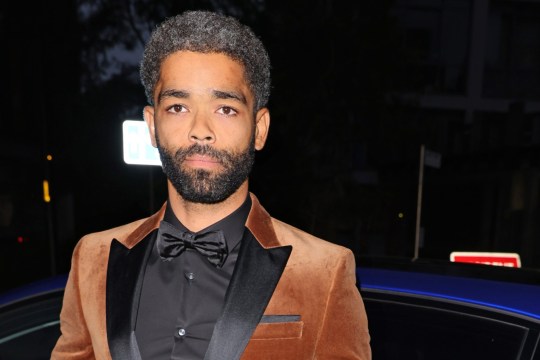
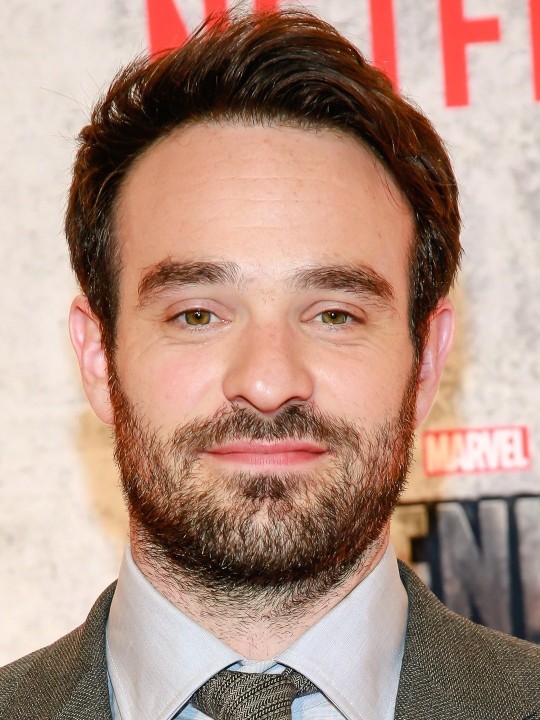

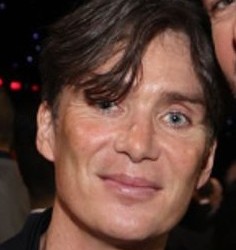

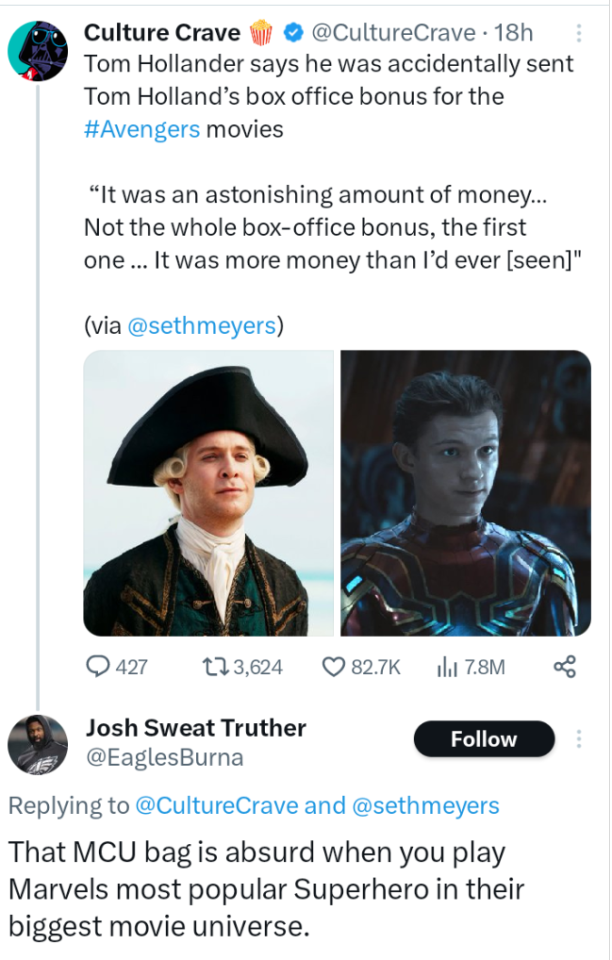
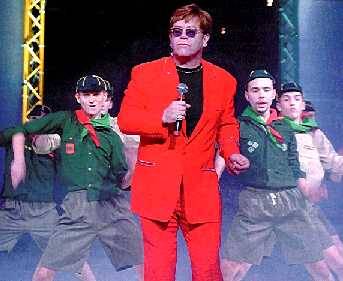
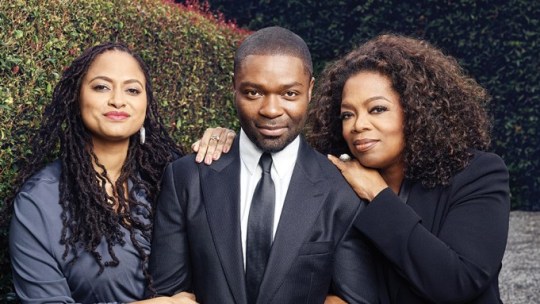
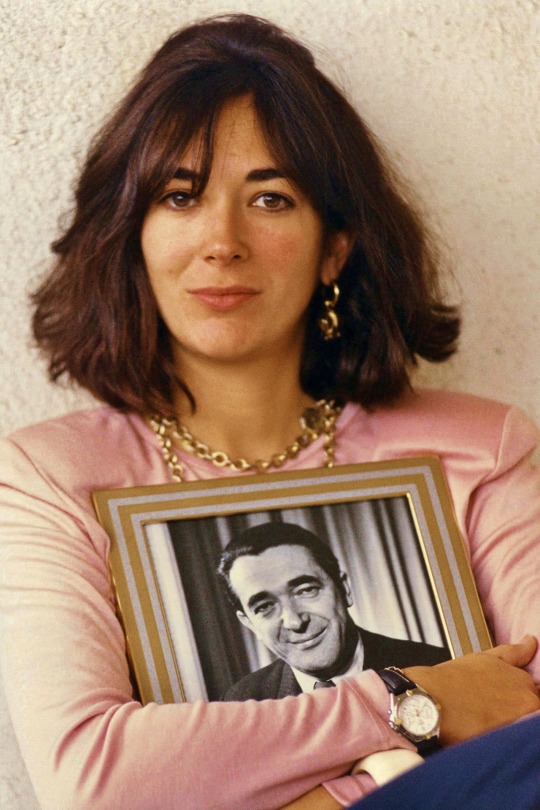
#Jamaica and The Legendary Marley Family Sell Patriarch Bob Marley Down The River For Weak Tepid White Washed One Love#Starring British Lavender Mafia Boy Kingsley Ben Adir#Irish Mob#Corrupt British Film Industry#British Thugs Allowed To Play Historic Black Figures#Malcolm X#Barack Obama#Hollywood Gay Mafia Connections#Scientology#Sony Pictures David Geffen#Warner Bros#David Zaslav#IAC#Barry Diller#Kingsley Ben Adir#David Oyelowo#Tom Hollander#Kristen Stewart#Elton John#Cillian Murphy#Stephen Fry#Mark Gatiss#Capote and The Swans Star Used In Threat Against Spiderman Star Tom Holland#British Parliament#BBC#ITV#Jamaica Compromised#Charlie Cox#Daredevil
8 notes
·
View notes
Text
Thus Fate Knocks at the Door - Adam, Eve, and Beethoven's 5th Symphony




SK8 as a series almost exclusively utilizes its (excellent) bespoke soundtrack for its music, but there are a few conspicuous exceptions, all to do with Adam. Specifically, there are two notable scenes in episodes 1 and 5 that make use of Beethoven's 5th Symphony—as music that he is, in-universe, listening and humming along to as he watches Langa skate for the first time, and as the score to the scene where he first declares Langa his "Eve."
This isn't an arbitrary choice of a famous piece of classical music, but representative of a consistent theme in Adam's characterization, especially in regards to his feelings toward Langa: his preoccupation with fate and the idea that they were destined to be together.
One doesn't have to look very far to draw a connection between this and Beethoven's 5th Symphony; there are a variety of unconfirmed stories about the origin of the famous four-note motif at the beginning of the piece, but the most famous comes from an account by Beethoven's secretary, Anton Schindler.
The composer himself provided the key to these depths when one day, in this author's presence, he pointed to the beginning of the first movement and expressed in these words the fundamental idea of his work: "Thus Fate knocks at the door!"
Schindler's writings on Beethoven after his death are... unreliable, to say the least, with many of his stories about the composer known to be outright fabricated, so it's very likely that this story is apocryphal. Nonetheless, it's one that's ingrained in public consciousness, and the influence of this particular account is especially obvious in Japan, where the whole symphony is known by the title "運命", or "Fate". It could even be said to be better known by this title than just its real name; if you search "交響曲第5番" on Youtube, Spotify, or even look at Japanese CD jackets, it is invariably referred to as 運命.
運命 is a word Adam himself uses in the show, in the preview at the end of episode 4, translated here as "destiny":
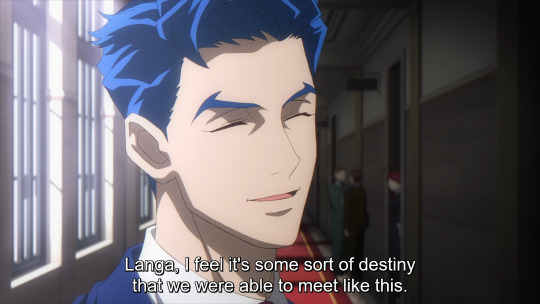
This concept of fate/destiny is one that permeates Adam's entire search for "Eve"—a desire to find someone "just for him", as he puts it in the flashback in episode 8.
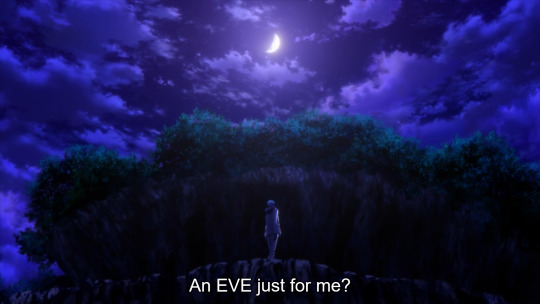
The title for episode 8 itself refers to fate, albeit with the word 宿命 rather than 運命—with the title first being shown over the shot revealing the "fated tournament" in question being named "White Eden Wedding Beef".

There's a bit of nuance to 宿命 and 運命—strictly speaking, 運命 refers to fate that can change in one's lifetime, while 宿命 refers to fate set in stone before one is even born. Regardless, they're near-synonymous; the tournament named for the Garden of Eden, that Adam holds for the specific purpose of skating with Langa again, is called fated.
Both words for fate/destiny also appear in the lyrics to the Japanese version of Behind the Mask:
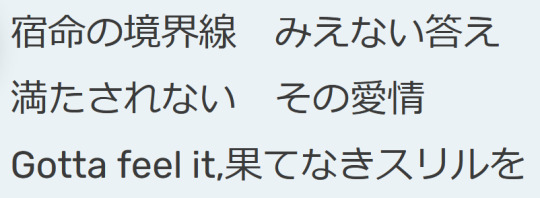

The boundary line of fate, an unseen answer To that unfulfilled love Gotta feel it, the never-ending thrill
Sparks spread high Let's go to the depths of the colored rainbow and speed Yes, now, dancing in the midst of destiny I devote my love
The first uses 宿命, while the second uses 運命 (though pronounced "sadame" rather than "unmei" as it usually is here; this is a common enough affectation in lyrics, though さだめ does typically have the same implication of totally fixed fate as 宿命.) The first chorus also has the same line about "dancing in the midst of destiny" in it, but I chose this one for the fact that the direct reference to the Zone ("the depths of the colored rainbow") makes clearest that this version of the song, presented as being sung by Adam, is also directed at Langa.
Even the Chill Out! manga, lighthearted as the comics are, zero in on this fixation on fate/destiny in two different comics showing Adam's inner thoughts.
There's Line∞6, where, in his daydreams, Adam imagines Langa saying "この気持ち… もしかして愛抱夢が… 俺の運命のアダム…?" ("This feeling... Could Adam be... my destined Adam...?", using katakana for the biblical Adam to distinguish from Adam's S name in kanji), as though Langa has been searching for "his Adam" in the same way:
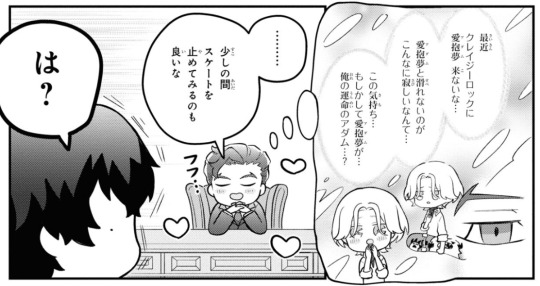
And Line∞8, where Adam refers to himself as Langa's "運命の伴侶"—soulmate, or literally "destined partner":

So it's this throughline, specifically in regards to Langa, that's reflected in the choice of music in episodes 1 and 5. The very first time he lays eyes on Langa, and when his heart is really set on Langa being his Eve—his "destined partner"—Adam truly does believe it's fate that they met, and the crew chose a song with such a heavy link to fate to represent his state of mind.
25 notes
·
View notes